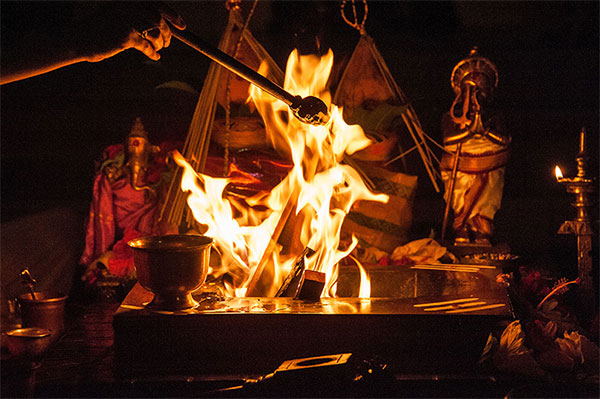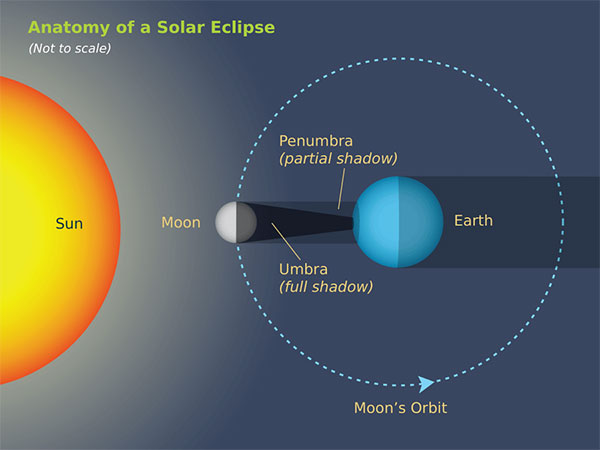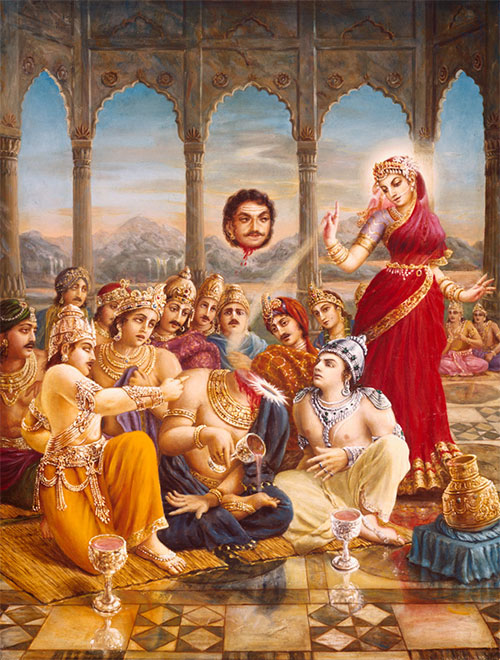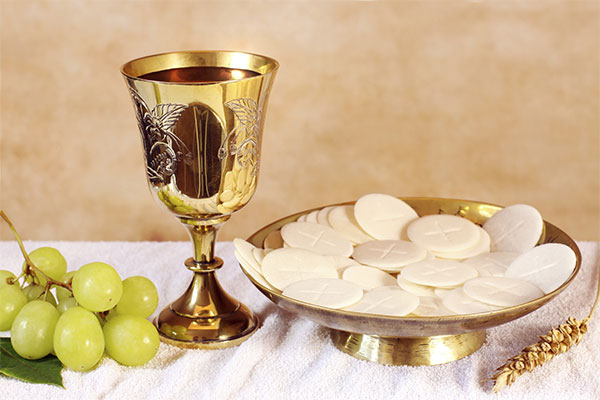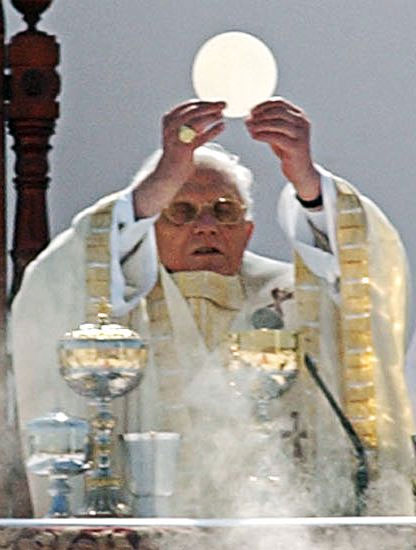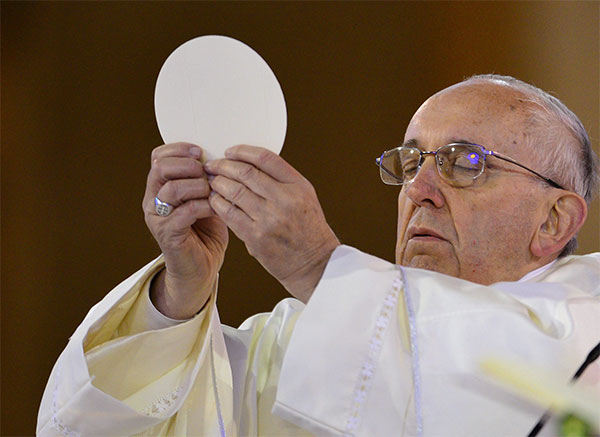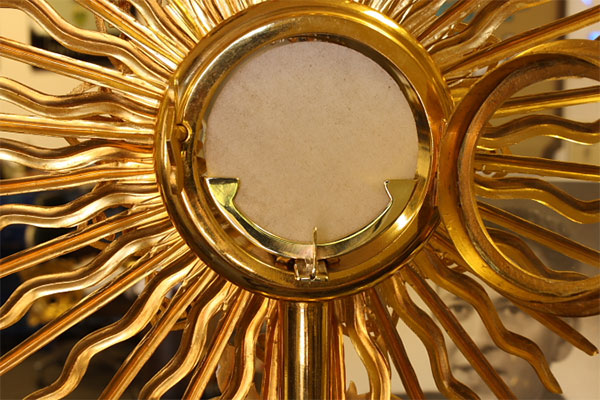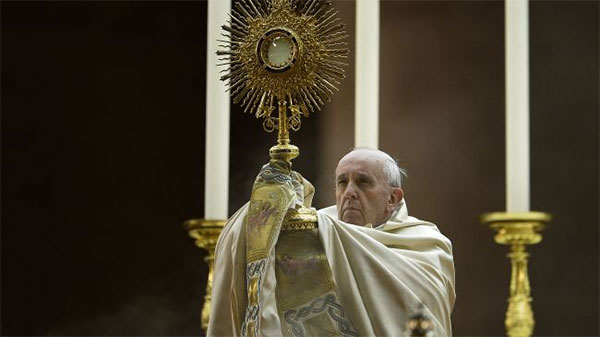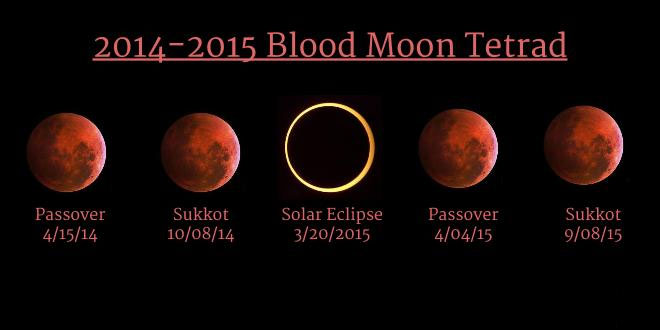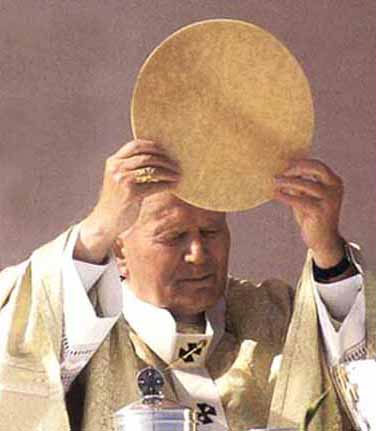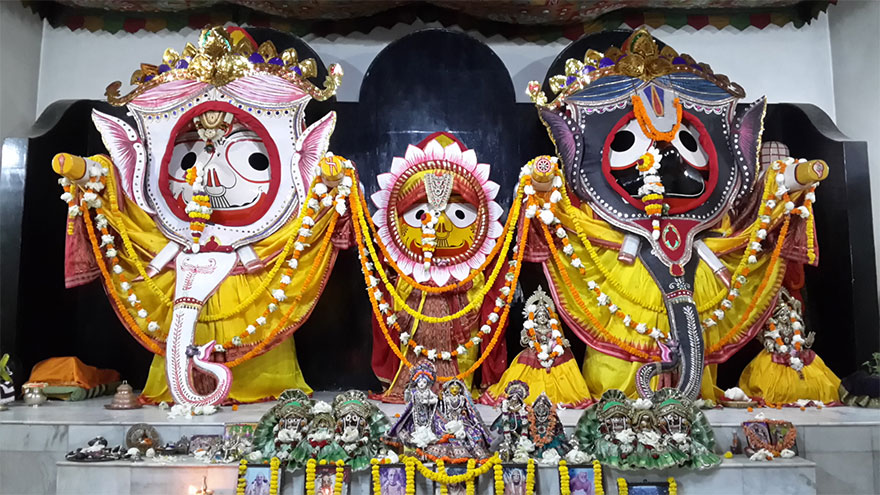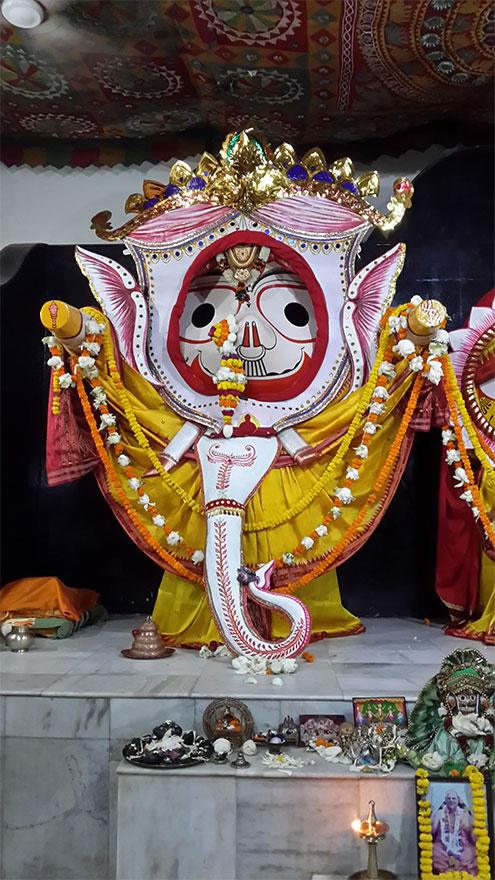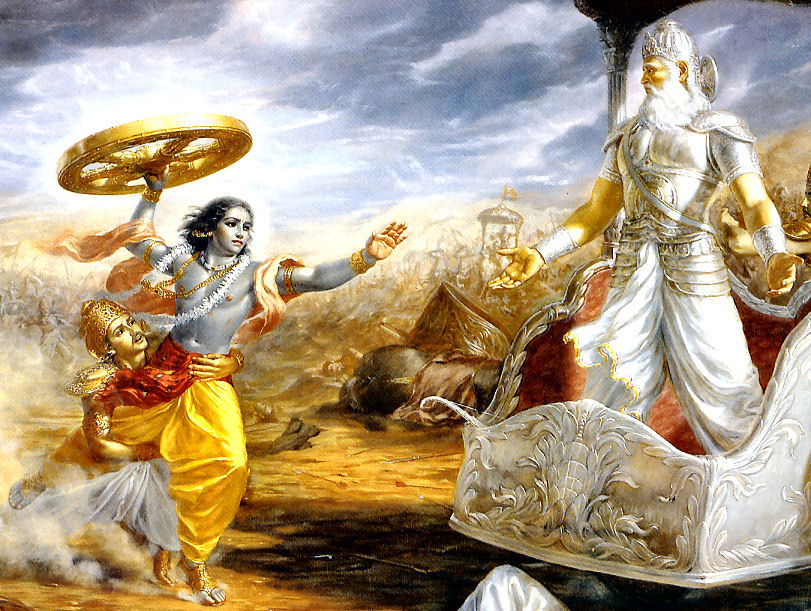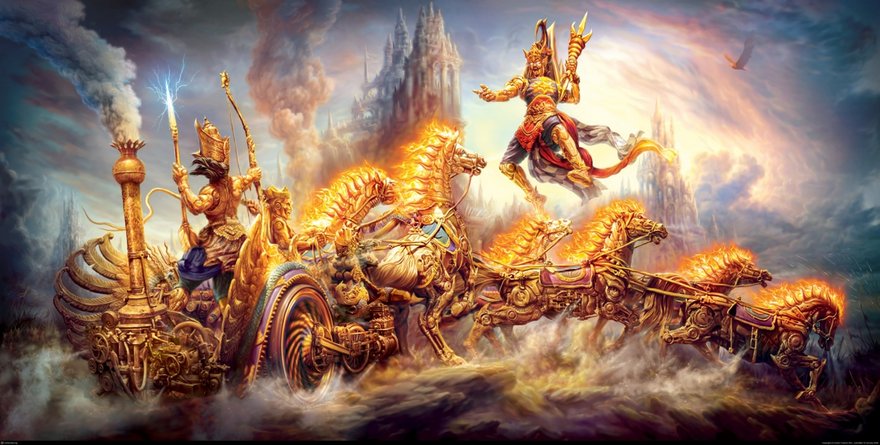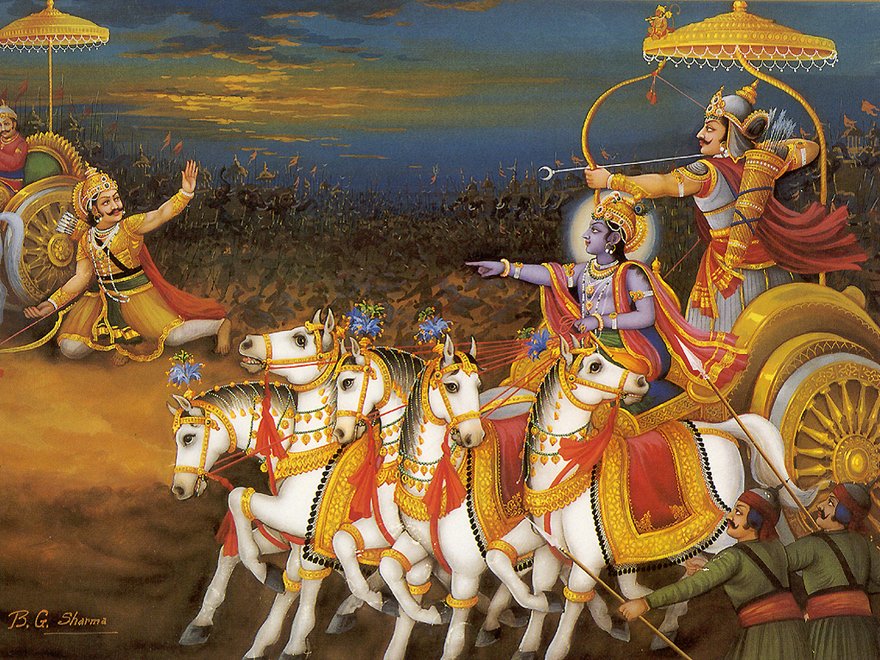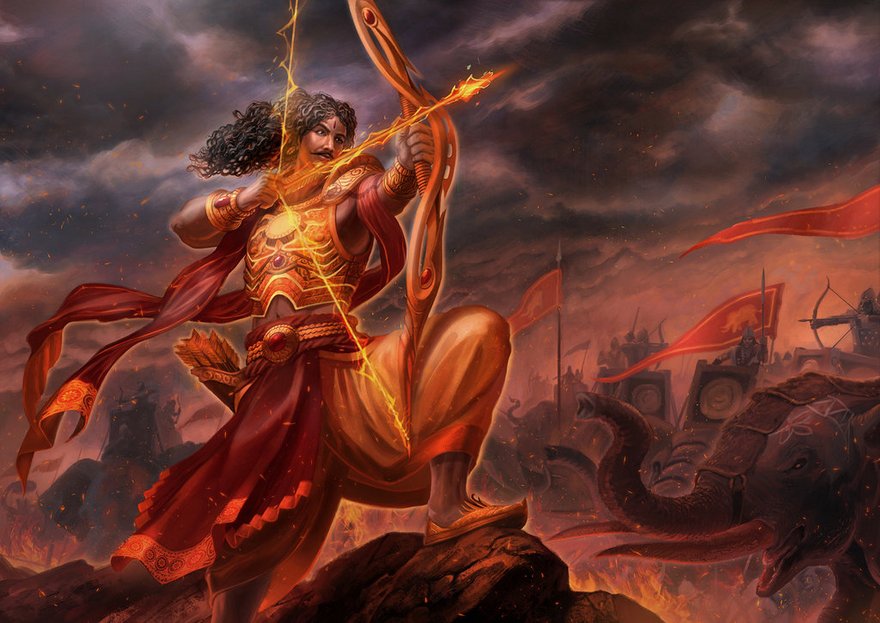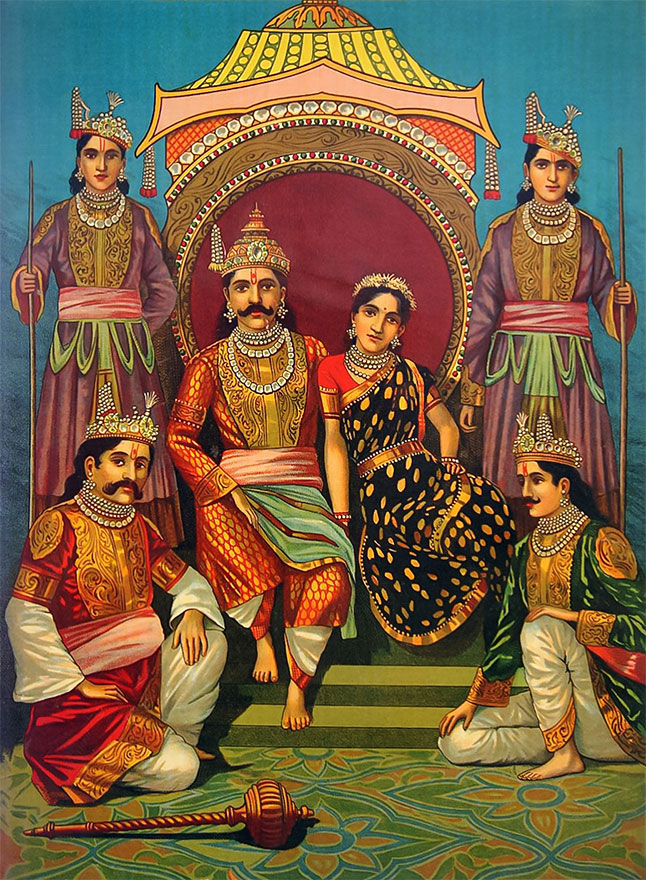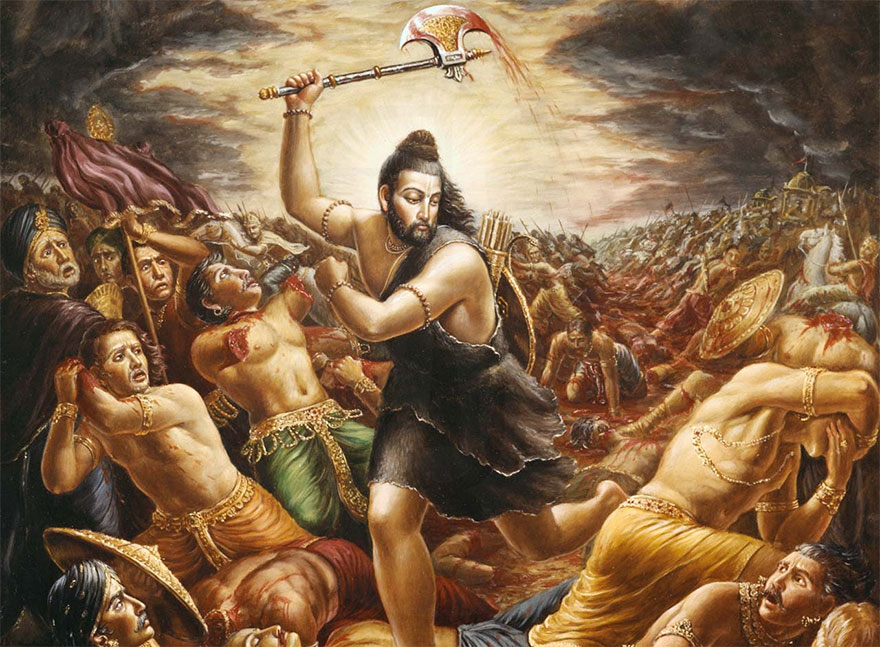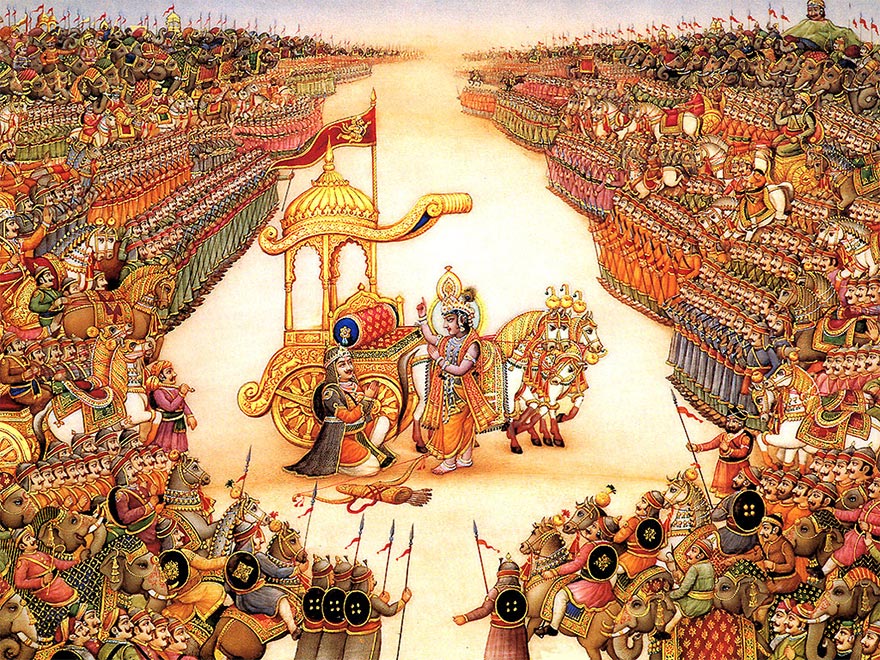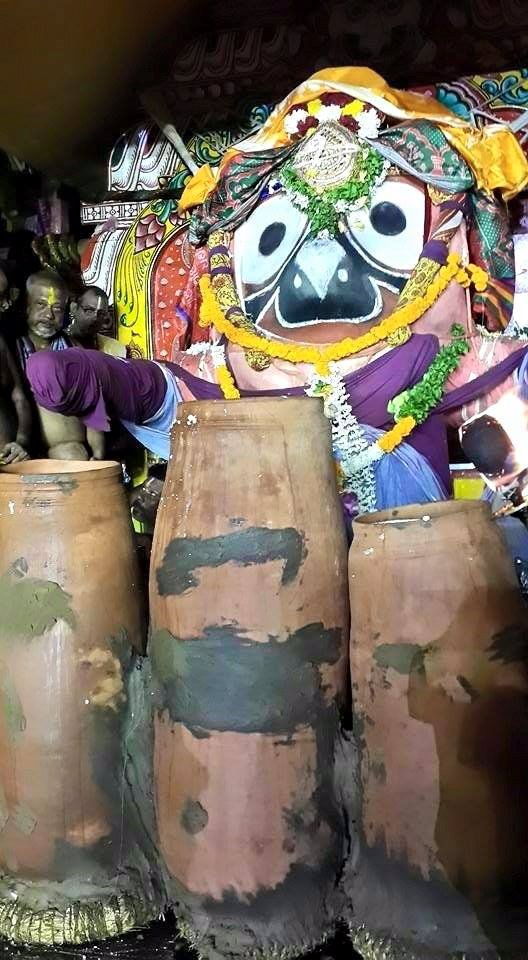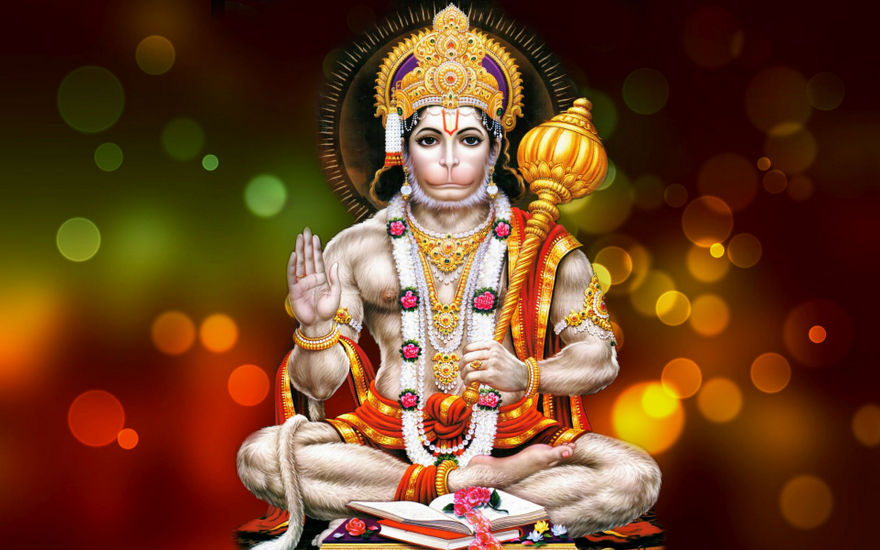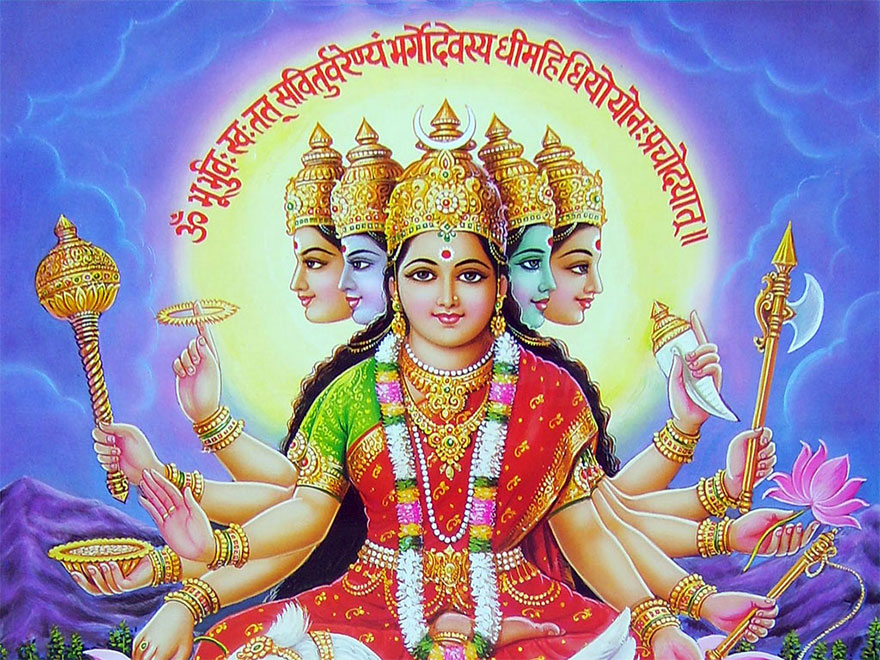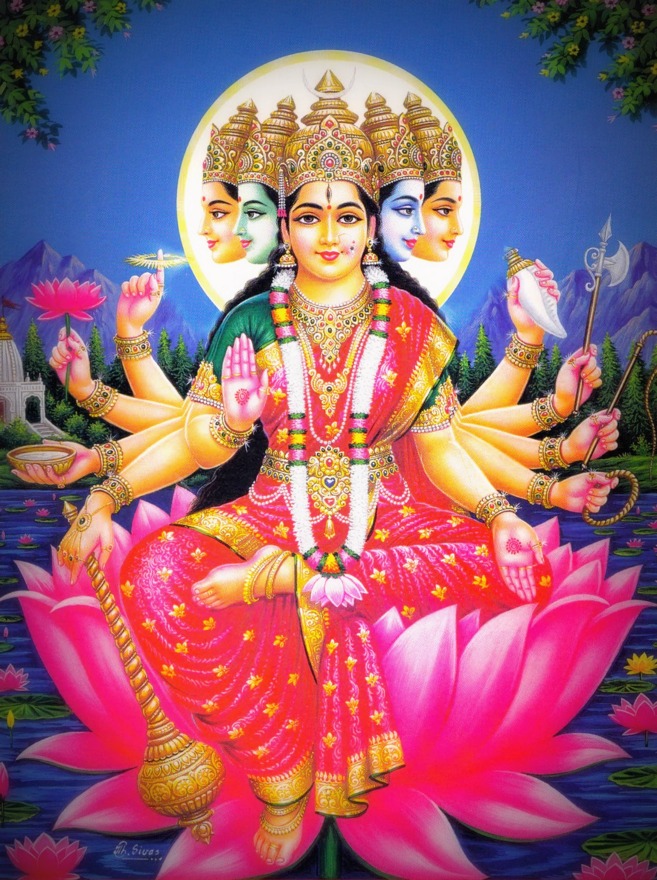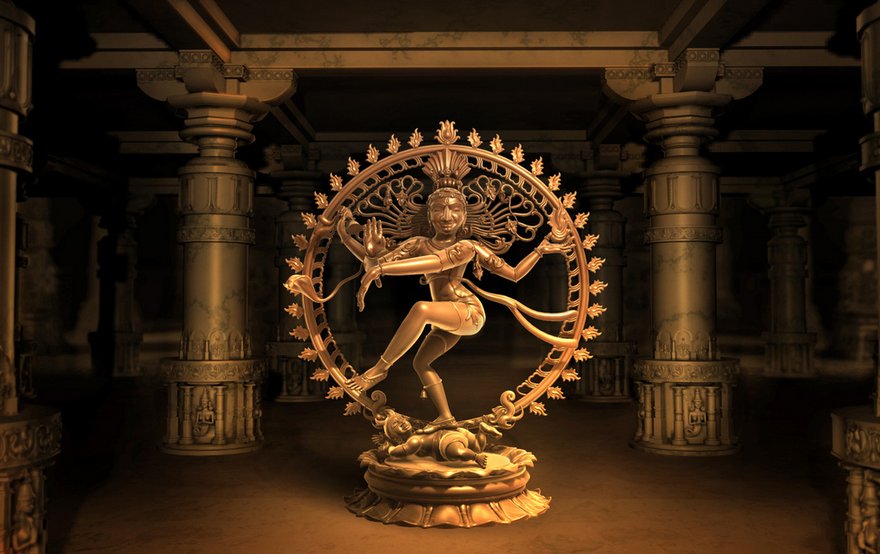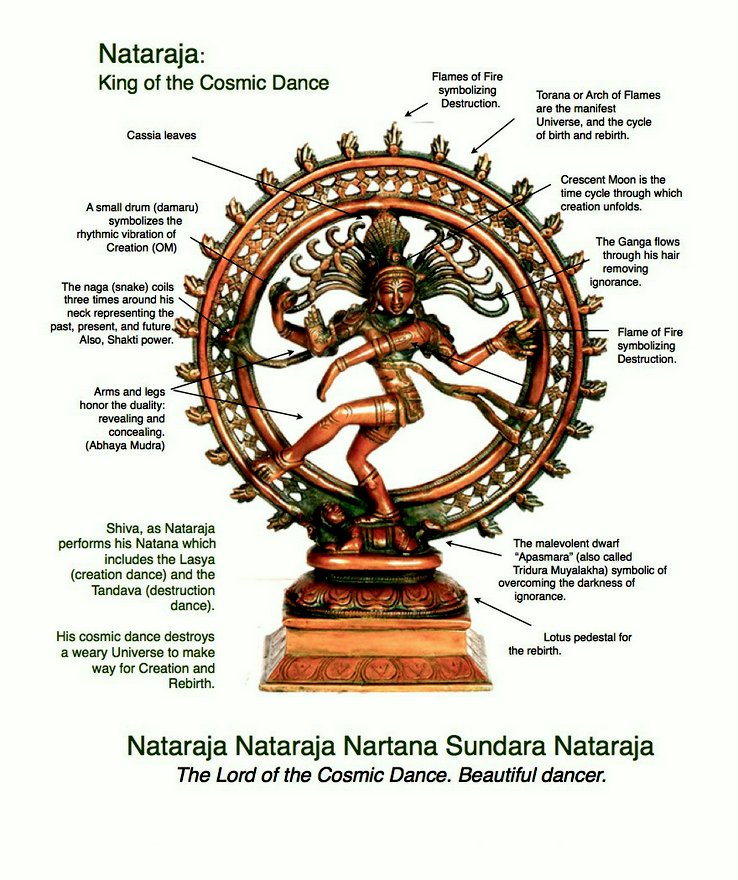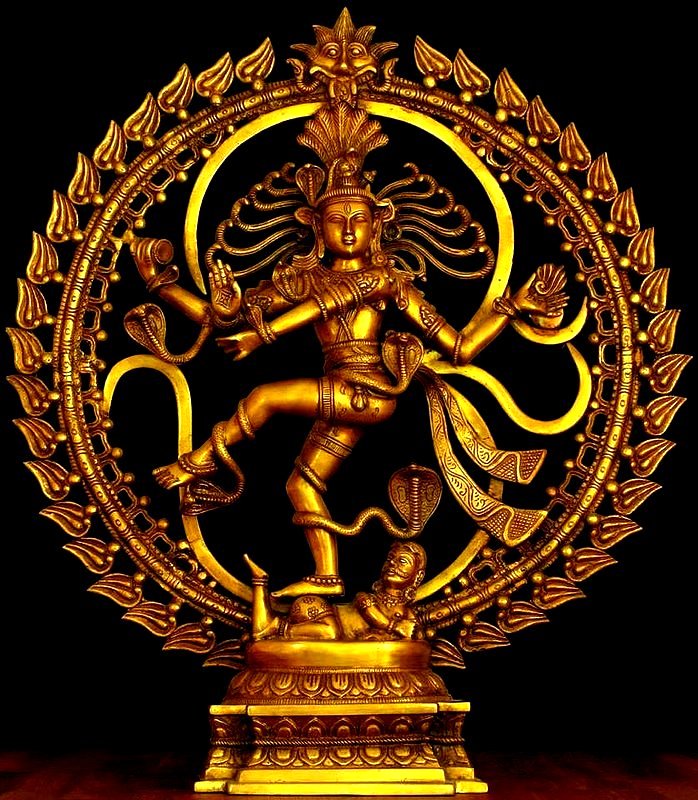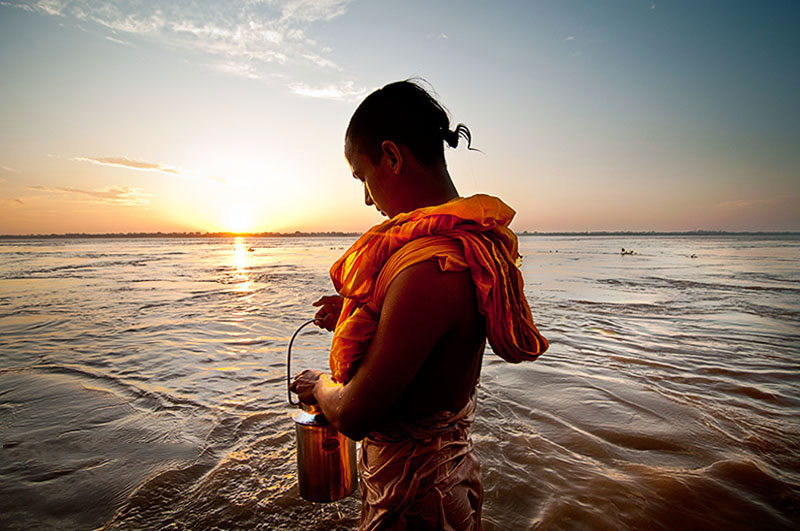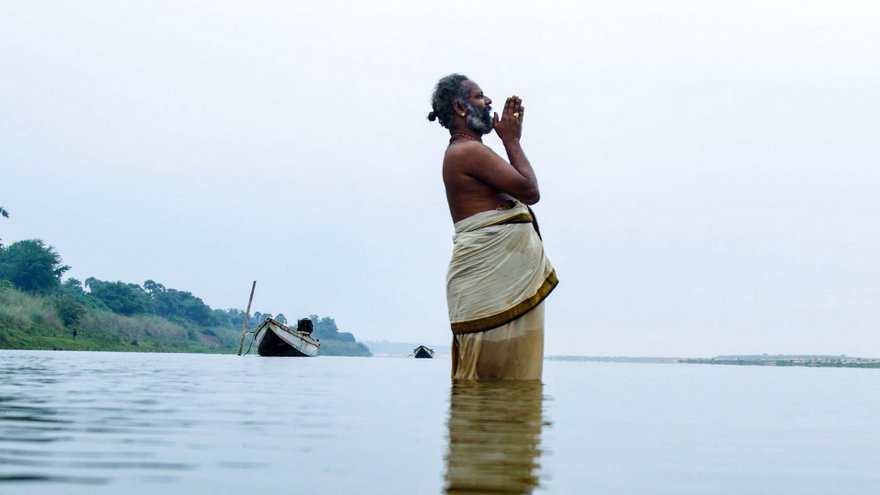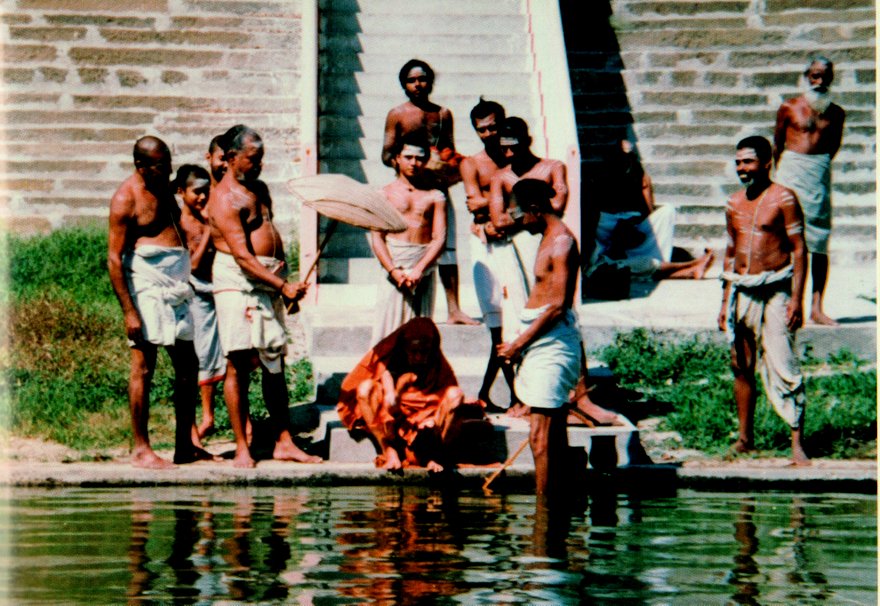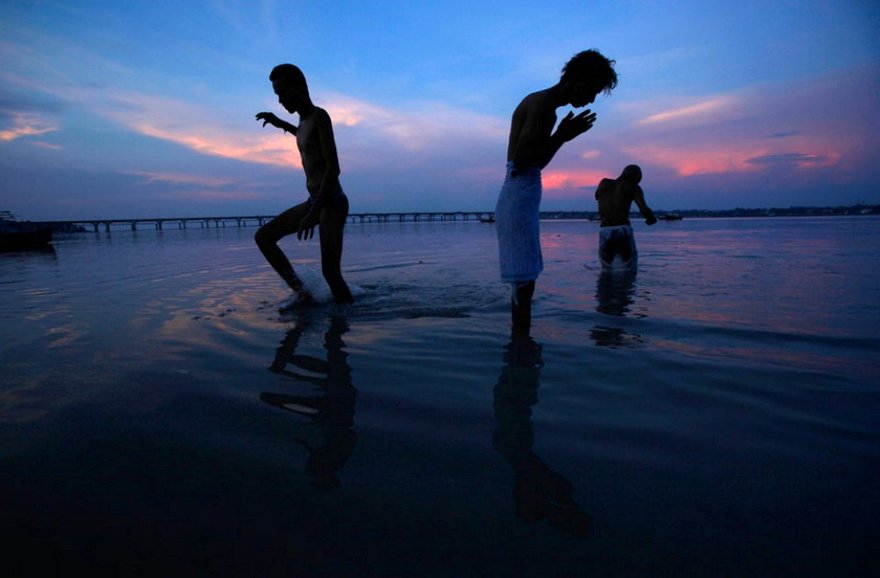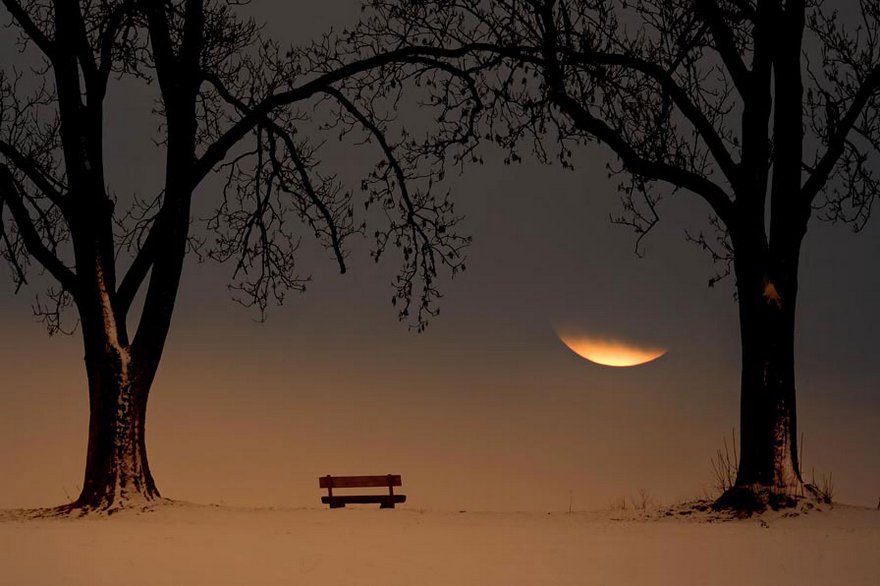![Paramartha Guru]()
A humorous fable from South India about a bogus guru and his five useless disciples. Each episode of the story defeats one of the six atheistic systems of Vedic philosophy (shad-darshanas). Here we provide only the story. The philosophical analysis is not included.
Chapter One
Long, long ago in a little village in South India, there lived a poor, aged simpleton called Paramartha. He was a bogus guru who had five equally bogus disciples. Their names were Mudhead, Foolish, Weakling, Idiot and Rascal. Since all gurus and their disciples live in ashrams, they did too and their activities and experiences together were many.
One morning the guru and his disciples set out for a temple in a neighboring village. On the way Paramartha explained life to his eager disciples:
“It’s so simple,” he said, “life is what all living things have, and all living things move. Look at this tree. It’s leaves move and so we can safely say that it is a living thing. Do you understand?”
“Oh great and wonderful guru,” his disciples chorused, “you explain the most difficult things in the simplest ways. How fortunate we are to be your disciples!”
Soon they came upon a river and the guru called one of his more senior men:
“Rascal, do you know whether this river is asleep or awake? I know from previous experience that this river is a very cunning river. We must be very careful with our dealings with it. Before venturing across it we need to know whether it is asleep or awake. Please go and check the situation.”
Rascal, eager to please his guru, ran to the riverbank. Plan in mind, he searched for an old, dry, tree branch. Quite soon he found one and set fire to it.
“Hmmm,” he thought, “I will burn this river. Then I will soon know if this river is awake or asleep.”
As soon as Rascal put the burning branch into the river he heard a loud hissing sound. It frightened him so much that he fell over. Shivering and shouting, he got up and ran to his guru:
“My dear guru! Now is definitely not the time for crossing this river. It is very much awake! As soon as I touched it, it hissed loudly and covered me with smoke. It was so angry I was afraid it would get up and hit me. It is only by your great mercy and the mercy of my parents that I have come back alive. What a terrible experience!”
“Please calm down Rascal,” said the guru. “What can we do? We have to accept this as the arrangement of God. We will just have to wait until the river falls asleep.”
And so guru Paramartha and his disciples took shelter of a nearby garden and discussed the cunning nature of the river they were attempting to cross. Fool, one of the more philosophically inclined of the disciples said:
“Guru maharaj, I have heard a great deal about the river mind and about this river in particular. We cannot afford to underestimate its prowess. My grandfather has had personal experience of its temperament. He is a very successful merchant and one day, returning from one of his business ventures, he happened to pass this way. His assistants, and two donkeys laden with salt bags, accompanied him.”
“It was summer and the day was hot. They decided to take bath and give the donkeys some rest. Both men and donkeys stepped into the cool waters of the river, bathed and then spent some time under the green shady trees. When the heat of the day had passed they again went on their way.”
“The party had not been traveling long when one of the assistants shouted in dismay: Oh no! Master, look! The salt bags are still well stitched but they are wet and there is no salt in them. Where has it gone? Who is responsible for this?”
“Actually, we are very fortunate,” replied my grandfather after some thought, “If this river had not been able to rob us of our salt it may have become angry and swallowed us all. We have been saved by God. We are very fortunate indeed!”
“And so all the servants were satisfied and continued on their way.”
While Fool was discussing the nature of the river mind with his guru a man on a horse came by. Despite the warnings of the disciples, he entered the river and quickly and easily reached the other side.
“What an extraordinary feat,” the amazed Paramartha guru exclaimed.
“Yes,” chorused his disciples.
“Guru Maharaj,” said weakling, as they watched the horseman disappear into the distance, “If you had a horse all our problems would obviously be solved. We wouldn’t have to worry about these tricky rivers anymore. We could easily cross them. Why don’t we buy a horse?”
“Later,” said the guru, “we can discuss that later. Right now we have more important matters at hand. Evening has come. I think the river is now sleeping. Otherwise how could that horseman cross it so easily? Yes, I’m confident it is now asleep. Mudhead, please go and check.”
Mudhead, though eager to serve his guru, was not the most intelligent of his disciples.
“This is a very difficult task,” he thought, “I don’t want to displease my guru, so I will use Rascal’s system to check whether the river is sleeping. Yes… better to follow a proven path. Now, where is that branch he used?”
Finally he found the branch, black and water logged as it was, and ran to the river’s edge. Gingerly he plunged it into the river, and to his relief, no sound or smoke came.
“Ah, guru maharaj will be pleased,” he smiled. Quietly he tiptoed back to his fellow pilgrims. “Dear guru maharaj, this is the time. We must go now. This opportunity may not come again so easily. The river is presently in deep sleep. Please, don’t make any noise and step very carefully. If we go now and are cautious, the river will not wake up and we will be able to cross it without difficulty. Come!”
As soon as guru Paramartha and his disciples heard this they immediately got up and slowly, step by step, began to cross the river.
Hearts palpitating, ears magnifying the smallest sound, they stealthily waded across the river. When what seemed like an eternity had passed, they finally reached the other side. Immediately three of the disciples began jumping and dancing in ecstasy.
“Guru Maharaj, how wonderful you are. By your mercy, we have finally crossed this terribly dangerous river. All glories to you, what power! What intelligence! What……”
“Don’t be too happy yet,” Fool interrupted, “let us check whether in fact we did all arrive safely on this side.” And with that he began counting the members in the party. As his name suggests, Fool was not the most intelligent of men and hence he forgot to include himself in the counting.
“Oh no! What a loss, what a great loss!” he exclaimed. “When we arrived at the river’s edge we were six in number and now we are only five. We have lost a person. What a treacherous river. What a disaster! What……..”
“Wait,” interrupted his guru, “don’t be too quick in your conclusions. This is not the character of a sober man. Please let us sit down and I will count.”
And so guru Paramartha began to count. Being a simpleton, he too forgot to include himself. Once, twice, thrice he counted and each time he counted only five members in the party. Confused, he locked his skinny legs in padmasana and meditated on the matter for some time. Finally he opened his eyes and with sobriety and detachment said to his disciples, “We must see this as the arrangement of God. We have lost a man. This river is indeed a treacherous one. Even while sleeping it has managed to cause some mischief. This loss has deeply affected my heart but what to do? We must remember we are sadhus and remain aloof from the influence of such distress.”
In a state of panic his disciples frantically began to count and each came to the same conclusion. There were now only five men. One, two, three, four, five. A mood of intense lamentation filled the air and all the disciples began crying and rolling on the ground. The screaming and sobbing was so intense that guru Paramartha lost his composure and began cursing the river:
“Oh evil-minded river! What an outcaste you are! Have you no mercy? Were you not born with brothers and sisters? Can’t you understand the grief your callousness has caused us? My disciples are such a wonderful and intelligent group of men, an inspiration to any guru, and now you have mercilessly swallowed one of them. Even though we were considerate and didn’t disturb your sleep, you cheated us. Being sadhus we will not take action against you, but rest assured that one day you will also be cheated.”
Like mad men, guru and disciples continued to curse and cry. The air was pierced with arrows of loud abuse, anger and lamentation.
At that time a pilgrim was passing by and he was amazed by the strange sight and intensity of noise. “What a curious sight,” he thought, “why are these people so disturbed I wonder? They look very upset. Something terrible must have happened. Let me make some inquiry into the matter.” And so he walked up to them and said, “My dear sirs, what is wrong? Why are you in such distress? Has someone died? Please tell me.”
“My dear friend,” lamented the guru, “you could not possibly understand our grief. Previously I had five wonderful disciples. Now, by the treacherous mischief of this river I have only four. What to do? Such a great loss has caused us intense pain.”
Hearing this the pilgrim himself counted the men and saw that there were factually six members in the party, one, two, three, four, five, six. “What a group of simpletons,” he mussed, “let me see what fun is to be had from them.”
Solemnly offering obeisance’s to the guru the pilgrim said, “I can understand your grief. This river is indeed a treacherous one. Please allow me to assist you. I am very expert in the Atharva Veda. I know all about ghosts, yakshinis, gandharvas and so on and they are all under my control. They will follow my instruction. Please offer me a little gift as dakshina and I will call your disciple back from the river. It is my duty.”
Hearing this the guru became overwhelmed with joy.
“Dear Sir,” he lauded, “you are a Godsend. I am deeply impressed that though you are so learned you are prepared to help we poor sadhus. We are most grateful and are prepared to give the little we own as dakshina. Please, kindly bring our man back to us. We’ll give you 45 gold coins.”
The pilgrim, overwhelmed by the thought of gaining 45 gold coins so easily, was quick to act.
“My dear fellows,” he said as he theatrically took a large stick from his possessions, “All stand in a line, bend down and close your eyes. Don’t move or open your eyes, but when I touch you say: I am here! and give your name. In this way I will be able to bring your dear friend back to you. Do you understand?”
“Yes, yes,” they all chimed and eagerly formed a line. Being simple souls they were fully confident that the man would fulfill his promise.
“Right,” said the mystic rolling up his sleeves, “please close your eyes and we will begin.” The men closed their eyes and waited. Within seconds they heard a very loud “Whack!!” followed by their guru screaming “enough, enough! I am here. I am Paramartha guru.” They then heard the pilgrim count matter-of-factly, “one.”
Trembling at the knees each disciple peeked through half closed eyes to see what had happened. The mystic was brandishing his large stick and their old guru maharaj was still on the ground trying to recuperate from the severe blow. Frightened, and feeling sick at heart they all looked to Rascal. He was a senior disciple. What was he going to do? Recognizing the gravity of the task Rascal braced himself to set a good example come what may. He was just in time for he also received a heavy blow. “Ouch! I am Rascal. I am here.” he said as rapidly as he could. And the mystic matter-of-factly counted , “two.”
Slowly one after another he beat each of the six men, counting as he did so. And he counted six. One, two, three, four, five, six. Then he said, “please open your eyes. Now, as you can plainly see, you are six again. I have successfully called back your lost man. Please give me my 45 gold coins and be happy.”
Guru Paramartha checked his number of disciples three times. Finally convinced that they were all present, he gladly gave the pilgrim his gold coins who, overjoyed, went on his merry way. The guru and his disciples embraced each other and marveled at their good fortune.
Enthused, they collected their few belongings and returned to their ashram – this time over a bridge.
Chapter Two
For many a day guru Paramartha and his disciples discussed their adventure. Very elaborately they described how they eventually managed to cross the treacherous river and still lose a person. They marveled at how a God sent messenger had brought back their missing man for a mere 45 gold coins.
Meanwhile, the old lady hired to do all the cleaning in the ashrama, listened attentively. Though she was blind, her hearing was as keen as her wit. “My dear boys,” she said, “you have been badly cheated. You have lost 45 gold coins unnecessarily. Your difficulty was not a serious one – certainly not worth 45 gold coins. Let me tell you, if at any time you cross a river and want to count your men, there is a much simpler and cheaper solution. Whenever you travel always carry some wet cow dung with you. Then when you cross the river, add some water, knead the cow dung, and make a big pancake out of it. Then you should put the cow dung pancake on the ground and all sit around it. Very carefully, one after another, put your nose in it and make a bold, clear impression. The rest is quite simple. Just stand up and count the imprints in the cow dung. In this way you can easily check how many people are present – and save yourself 45 gold coins.”
“Wonderful!” exclaimed guru Paramartha. “What a clever idea! This lady is very intelligent. Mudhead, please don’t forget, next time we go traveling we must definitely take some wet cow dung. What a fabulous idea.”
In the meantime Weakling had been meditating on his own plans:
“Dear Guru Maharaj, why don’t we buy our own horse? Do you remember how easily that man crossed the river? Life would be a lot simpler if we had our own horse.”
“Hmmm,” said the guru deliberating on the matter. “How much do you think a good horse would cost?”
“No less than 100 gold coins,” replied Rascal. “Well, we certainly don’t have that much money.
“We’ll have to forget the idea for now,” the guru concluded.
And so the proposition was postponed and life went on as usual. Then one day the ashrama cow, which had been put out to pasture, went missing. Guru Paramartha sent his disciples all over the village looking for it.
Eager to serve their guru maharaj, they searched high and low, leaving nothing unturned. However, to their dismay, the search was fruitless.
“What shall we do now?” they wailed looking at each other pitifully. “How could we go back to our master?” He will be very displeased with our failure to find his cow.”
Then Mudhead said, “Well my brothers, I’m not going back to the ashrama until I find it. I’m going to search the next town and the next one if necessary. Good day!”
And so he left. A little bewildered the other disciples just stood staring at him as he walked away.
Then Rascal said, “Come let’s go back to the ashrama. Our guru maharaj will be concerned about us.”
For three days Mudhead was absent. Then on the fourth day he returned tired and cowless but still happy.
“Why are you smiling, you fool.” guru Paramartha chastised. “You’ve been gone from the ashrama for nearly four days, and you dare to return with nothing but a smile on your face. Where’s the cow?”
“Dear guru maharaj, wait until you hear the good news,” replied Mudhead. “True I was unable to find the cow. However, I found something much better. I managed to get a very cheap price on a horse.” The angry look on the guru’s face softened. “Really,” he said, “that sounds wonderful. Please tell me the details.”
“Well, I was trying to find our ashrama cow. I searched so many nearby towns. People’s gardens, public parks, sadhus’ ashramas – I left no place untouched. Unfortunately, I wasn’t able to find the cow. Feeling a little depressed I was walking along the bank of a lake. Then by your causeless mercy and the mercy of God I saw a most amazing sight. There were four female horses grazing contentedly and next to one of them were two huge horse eggs. They were so big. Two hands weren’t large enough to hold one let alone two. Then I noticed a local villager passing by.”
“Kind sir,” I said, “who owns these wonderful horses?”
“Nearby, there lives a very rich business man,” he answered. “He owns these fabulous horses. They’re so amazing. They’ll learn anything you care to teach them – and so quickly.”
“Do you think he will allow me to buy one of their eggs?” I interrupted.
“Yes,” he said, “I’m sure he would be happy to help you. I don’t think he will charge you more than five gold coins. That’s a very reasonable price for an excellent horse, don’t you agree?”
“Wonderful! Wonderful!” beamed the guru clapping his hands. “A very fine achievement.” Then turning to his other disciples he asked, “Well, what do you think?”
“We certainly don’t have much to lose if the price is only five gold coins,” Rascal answered. “That’s true”, the others chimed, “It sounds a very profitable venture.”
“Rascal and Mudhead,” the guru said solemnly, “I want you to go and purchase the best horse egg immediately. Here, take the necessary five gold coins and some funds for travel expenses. We look forward to your return.” Then he placed his hand on their heads as a blessing. And they paid their obeisances and left.
After some time Fool, looking more than a little bewildered, meekly inquired of his guru.
“My dear guru maharaj. It is very amazing that we have found such a first class horse egg for such a cheap price. Please forgive me, but I have one question. “How will we get the horse out of the egg? In the village I’ve seen chickens. They have five or six eggs at a time and they sit on them until the baby chicks are ready to hatch. But even if we put 50 chickens on this horse egg it obviously won’t be enough. How are we going to get the horse out of the egg?”
“Hmmm!” pondered the guru, “the devil is certainly in the details. It will take me some time to answer your question.” And with that he folded his skinny legs into the padmasana and began to meditate. After three days the guru finally broke his meditation and called for his disciples. “My dear disciples, I have contemplated Fool’s question. The answer is quite simple. One of us is going to have to sit on this egg. There is no other solution. If we want an intelligent horse then an intelligent person is going to have to sit on it. All of you are of keen wit. Who will please me by sitting on the egg?”
Slowly he looked around the room and set his eyes on Fool.
“Please guru maharaj,” Fool stammered timidly, “how can I possibly sit on the horse egg all day. I must fetch water from the river, cut the fire wood and bring it to the kitchen. I have so much to do. Please forgive me, but it is impossible for me to meet your request.”
“I also can’t do this service,” said Idiot. “Day and night I am busy cooking in the kitchen. There are six of us plus the servants. I have to cut so many vegetables and cook so many tasty dishes. And you do like your rotis, guru maharaj. I spend the whole day very busily working in the kitchen, I can’t possibly sit on the egg.”
“Nor can I!” exclaimed Weakling, “I have to wake up before everyone else and go to the river and clean my teeth. It certainly hadn’t been my practice to do this before joining the ashrama. It’s a very great austerity for me. I also have to wash my own cloth and pick all the flowers for the garlands. I also have to keep all the lamps clean. I have so much work that it makes me tired just talking about it. I can’t sit on the egg. It’s impossible.”
“Yes,” agreed the guru, “it certainly is a difficult situation. Rascal and Mudhead are also very busy. The only one who is doing nothing is myself. A very intelligent person must sit on the egg for good results and so I’ll do it. I’ll embrace it with my head and cover it with my chuddar. I’ll treat it with great care and affection then we will definitely get an excellent result. It will be very difficult but worthwhile work. Yes, I’ll do it.”
In the meantime, after a two and a half hour walk, Mudhead and Rascal returned to the lake. The four horses were still grazing contentedly and next to them were many big, white pumpkins. As soon as Mudhead saw them he shouted excitedly:
“Look! There are so many horse eggs and they’re so big. Guru maharaj will be greatly pleased. Quickly, let’s go and see the business man who owns these horses.” And so they went.
The business man was lounging in his garden. The two sadhus pushed their way through the gate and ran to him.
“Dear kind sir,” Rascal blurted, “We are from Kutralam. We are sadhus. We want to buy a horse egg. You have such wonderful horses. We’re poor. Please give us a horse egg for five gold coins.”
The business man’s eyes gleamed. “What fools!” he gloated, “they want to buy a pumpkin for five gold coins. Let’s see what my fabulous horse eggs will fetch.” Turning to the disciples he said cunningly, “You must be joking, I can’t give these horse eggs for five gold coins. They are very rare and very special. I can’t possibly sell them to you so cheaply…..”
“Don’t try to cheat us!” scolded Rascal pointing his index finger at the man. “We are Sadhus. We have intelligence. We have checked the price with the town farmers. They told us five gold coins was a very fair price.”
“Very well,” complied the businessman. “You look like good natured sadhus and you are very intelligent. I’ll give you a horse egg for five gold coins. However, there is one condition. You are not to tell anyone that you got the egg so cheaply. Give me the five gold coins and go and choose the best of the horse eggs for your ashrama.”
Mudhead dumped the five gold coins in the businessman’s lap and then raced off with Rascal to the bank of the river. They looked discerningly at all the pumpkins and took the biggest one. Overcome by excitement and the taste of success they immediately began their long journey back to the ashrama. Along the way Rascal began to glorify their guru:
“Our guru maharaj is so advanced. He has such great mystic potency. I have often heard that for the spiritually enlightened the impossible is possible. Now I am seeing this practically demonstrated. I have never heard of a horse being born of an egg, but now, by the mystic potency of our guru maharaj, it is becoming reality. Not only is the impossible becoming possible, but it’s becoming possible so cheaply! Only five gold coins! This is truly miraculous!”
“Yes,” continued Mudhead, “You can always judge an activity by its results. Because of the greatness of our guru, God has sent a horse egg. It’s such a practical example. Our guru is great and by his mercy if we have faith in him we will also become great.”
In this way the two discussed their realizations.
Before long they came to a narrow path. Mudhead, who was carrying the pumpkin on his head, stopped talking in order to increase his concentration. Though treading carefully, he stumbled over a branch across his path and toppled, pumpkin and all. Rascal tried to catch the flying ‘egg’, but his frantic effort was unsuccessful and it fell with a “thud” into a nearby bush. There was a rabbit nibbling on some tender grass beneath that bush and when the pumpkin fell he became frightened, as most rabbits would. He ran from the bush.
“Quickly!” screamed Mudhead when he saw it. “Catch it! Catch it! There’s our horse. Catch him. He’s running away!”
Both of them chased the rabbit. Up hill and down dale they chased it, hour after hour they chased it. However, the rabbit was a fast one and they couldn’t catch him. Then, overcome with fatigue, Rascal fell over a rock and onto a thorny bush. The adventure resulted in a few scratches on his arms and chest and a bump on his head. He sat glumly looking up at Mudhead.
“Mudhead,” he said matter-of-factly, “I’m tired, I’m sore and I’m hungry. We’ve lost our guru’s horse and we’ve lost his money. What to do? I think its time for us to go back to the ashrama. It is not such a good idea to over endeavor.”
And so, hungry and with no money in hand, they made their way. As they came closer to the abode of their guru they became concerned that he would severely chastise them. Overcome with anxiety they began to beat their chests and even their stomachs. They howled and cried like wolves on a full moon night. Wailing the name of their guru they tentatively stepped into the ashrama. When their guru maharaj came before them they simultaneously turned a shade of ghostly white and fainted at his feet.
Mleccha immediately ran into the kitchen and fetched a large bowl of water. He ran back and threw it over his godbrothers. Rascal, who was first to come to his senses blurted:
“Such a fast horse! I have never seen a horse run so fast. It was two hands long and looked like a rabbit. It had four legs and two very big ears. It was so small but it ran so quickly. I don’t think it was an ordinary horse. Neither of us could catch him. Look what happened when I tried! We decided to return to the ashrama.”
The guru heard their story, pondered the matter and then looked at them affectionately. “You lost the five gold coins and that is not such a good thing. And the horse is also gone. Quite frankly I think that is a blessing. If it is able to run so fast at such a young age, what would it be like when it grew older. I am an old man. I can’t travel on a horse like that. I take it as a benediction that we didn’t get the animal. It would have caused us a great deal of difficulty. Let’s forget the incident. After all, it was only five gold coins. Don’t worry about it.”
The matter settled, guru Paramartha and his disciples went to take rest.
Chapter Three
After some days guru Paramartha decided that he and his disciples should go on a long pilgrimage. When he told his disciples they were immediately concerned. Rascal said, “Guru maharaj, you are old and weak. It would be most irresponsible and cruel of us to take you walking over such a long distance. The least we can do is hire a bull.”
“As you wish,” said the guru. “My life is in your hands.”
As soon as they heard this they went out to hire a bull. Luckily, there was a farmer in a nearby village who had a bull which wasn’t fit enough for agriculture but was certainly fit enough to carry an old man on pilgrimage. They agreed to pay three gold coins a day for the hire of the bull and proudly led it back to the ashrama.
Though it was a hot and heavy summer, somehow or other they managed to pack all their goods and chattels. Mudhead remembered the emergency supply of wet cow dung and having packed that, they set out on their way.
Though the tour began quite early morning, after a few hours of walking the heat became unbearable. They came across a place that was so arid that not even a blade of grass grew. The hot parched earth and lack of water made the situation unbearably intense. The poor old guru who was hungry and couldn’t get any water to drink fainted and fell from the bull.
Understandably upset, the disciples lifted and supported their guru and thought frantically about a possible place for him to lie down and take rest. An easy answer was not forthcoming.
Finally Mudhead said, “We have no choice. He will have to lie down here in the shadow of the bull. That is the coolest arrangement we can make in this place.”
Weakling took his chuddar and spread it beneath the bull for his guru maharaj to lie on. Then they all helped him on to the chuddar and Fool and Mleccha used their gumpshas to fan him. Slowly, slowly the guru recovered. As the day was spent it began to cool and a slight breeze blew. The disciples helped their guru once again onto the bull and went to a nearby village to take rest. It was in this little village that the owner of the bull lived.
Early next morning they went to the farmer to return the bull and pay the three gold coin hire charge.
“How dare you offer me this paltry sum?” challenged the farmer. “This is definitely not enough payment!”
“Excuse me sir,” answered Rascal, “but you previously agreed that we would pay three gold coins for a day’s hire of your bull. It is not proper for you to change your mind now!”
“Three gold coins gave you the right to sit on the bull and use him for traveling purposes. However, on the road, when the day became too hot, your guru rested in the shade of my bull. That was not in the agreement. Hence you have to give more gold coins.”
“This is ridiculous!” interrupted Fool. “We hired your bull for a day. Why should we pay extra for his shadow?”
Suddenly the man started swearing and the disciples were soon engaged in a brawl beyond their control. Immediately a large crowd, attracted by the harsh words and flying fists, gathered around them.
After sometime an elderly man came foreword, “What is the matter? Why are you fighting? Please calmly tell me your story and I will try to solve your problem.”
Mudhead, relieved by the sober interjection, began to explain the case. Patiently and attentively the old man listened to his tale. Then, very sagaciously he began a story of his own:
“Long, long ago I was traveling the country just like you two youngsters. I had my own foodstuffs with me and was simply looking for a place to eat and take a little rest. I spied a little hotel on the side of the road and approached the man in charge.
“Dear sir,” I said, “I have my own food, however I would like to relax in your little hotel and partake of it. Would you mind?”
“No. That doesn’t pose any problems. Please feel free to take a seat. Please understand, however that if you do take anything from our shop you will have to pay for it.”
I nodded my head, washed myself and sat down to eat. While I was eating my simple fare, a gentle breeze blew the scent of freshly cooked pakoras my way. One of the hotel cooks was busy preparing these fresh snacks. They smelt extremely tasty. However, being a poor mendicant, I couldn’t afford to buy any and so I just sat there, overpowered by the smell of delicious pakoras, eating my bag of rice. When I had finished I went to the hotel-in-charge to thank him for his hospitality. When he saw me coming towards him, he said “Don’t forget to pay for the pakoras.”
“Pakoras?” I said, “I didn’t eat any of your pakoras, I….”
“Come, come,” he interrupted, “I was watching you. You could only eat that bag of old rice because of the smell of our pakoras.”
Well I didn’t know what to do. Then another man in the hotel came forward to support his in-charge.”
“It is only by the smell of our pakoras that you could eat your rice. You will have to pay some fee. Usually people eat our pakoras and they pay in coinage. However, because you smelt them, you will have to pay by smelling.”
Finding the whole situation incredulous, I asked, “And how do I do that?”
“It’s simple,” he said matter-of-factly. “Please give me your little money pouch.”
When I handed it to him he immediately started rubbing it against his nose. He did this for some time and then he stopped.
“There,” he said, “that is enough payment for the smell of the pakoras. I don’t want to lose my nose.”
Then the two went back into the hotel satisfied that the debt had been paid.
So… just as I paid for my smelling of the pakoras, you can pay for using the shadow of the bull. You can pay in sound. Just shake your money bag in the ear of the bull for some time and your debt will be cleared.”
Amazed at the old man’s philosophical and practical understanding of the situation, Mudhead immediately took the money pouch and began to shake it in the ear of the bull.
“That’s enough,” the old man declared. “The bull has heard the sound of your coins. That’s enough. You have now paid for the use of the shadow of the bull. Please go now.”
Grateful for the help of the old man had given, Mudhead and Rascal paid their respects and hurried back to their guru. What remained of the afternoon was spent philosophically discussing the venture.
Chapter Four
Next morning guru Paramartha and his disciples got up very early because they didn’t want to travel in the hot sun. After some hours of travel they came across a well-shaded garden and decided to rest there to avoid the midday heat. Still feeling fit despite the journeying, Fool explored the garden and soon found a crystal clear lake filled to the brim with refreshing cool water. He took bath and immediately felt wonderful.
At the bank of this lake was a temple of the demigod “Iyyanar”, the village’s presiding deity. It was the practice of the local villagers to sculpture clay horses and elephants to decorate the boundary wall. This demigod assisted Lord Shiva in controlling the ghosts and goblins and hence it was considered important that he be satisfied by an offering of beautiful artifacts for his temple.
Amidst his frolicking in the lake, Fool came across the reflection of one such sculptured horses. Immediately he became frightened, because although the sculpture was standing still, the horse in the lake was moving.
Even if Fool tried to stand very still, the horse moved. And when he tried to leave the lake it became agitated and angry. It made no noise but it certainly was active. In fear of his life, Fool scrambled out of the lake and ran back to his guru maharaj. When he arrived at the camp site his legs were shaking and he was gasping for breath.
Aware of his disciple’s distress, guru Paramartha immediately got up and ran to him.
“My dear boy,” he asked holding his shoulders, “what has happened? You look as pale as a person haunted by a ghost. Please sit down. Tell me what happened.”
“Maharaj! Maharaj! There’s a fierce and powerful horse in a little lake nearby. I was quietly going about my bathing duties when he became so agitated that I thought he was going to attack me. It was only by your sublime mercy that I was able to leave the lake rather than my life! What shall we do? That is the only lake for bathing but a terrible monster lives there. What shall we do?”
More than a little confused, the guru turned to his other disciples, “I have trained you sufficiently to deal with such problems. What do you suggest we do?”
Mudhead replied immediately, “This is a wonderful idea, guru maharaj! We have wanted to provide a horse for you for so long. Horses are only really a problem when they’re frightened. Why don’t we offer it some cooked dhal, befriend it, and take it back to the ashrama.”
“Very well,” his mentor replied. “We will try your idea. However, I don’t want anyone to enter the water. He may bite. Let’s just leave the dhal on the bank of the lake and see if he can be coaxed that way….”
“My dear guru,” suggested Rascal. “Why don’t we try something a little quicker and simpler. Why don’t we just hold a bundle of grass above the water. I’m sure he’s hungry and when he sees it he will be quick to try and make it his. Then we can catch him.”
“Even that is an over endeavor,” interrupted Mleccha. “All we have to do is make a noise like another horse. He will come out immediately if he thinks there is another horse on the bank. If that doesn’t work we can just put a buffalo in the lake. The horse wouldn’t be impressed by that. I’m sure he would come out. Either way we would be in a good position to catch the animal.”
Fool, who had been meditating on the problem for some time, interjected with an air of certainty, “These ideas are all quite good. However, they do not take into consideration the circumstance. This horse is in a lake. Why don’t we just make a fishing rod and catch him like we would catch a fish?”
“Well thought out Fool, that is an excellent idea!” exclaimed the guru.
“Yes,” echoed his disciples, “this is definitely the best idea. Let us see what we can do to please our guru maharaj.”
Eagerly all the disciples ran off in different directions. Within a few moments one of them came back with a garden knife. Another brought a bundle of cooked rice, yet another brought the guru’s walking cane. Then Mudhead removed his turban and asked for all the different items. His idea was that the guru’s cane would be the fishing rod, the turban cloth the fishing line, the knife the fishing hook and the bundle of rice the bait. Deftly he made the peculiar contraption and threw it, hook line and bait into the water. Because of its weight and size, the lake suddenly became a mass of converging waves. The horse appeared very angry. Its legs were going in all directions and he seemed to be shaking his head ferociously. In fear, all the disciples fell back onto the riverbank. Mudhead alone persevered. He held onto the cane and waited until the waves calmed down.
“Don’t be afraid,” he said to his godbrothers, the horse has calmed down now. If we are quiet and patient I’m sure we will catch him. Let’s try.”
Meanwhile, attracted by the huge bundle of rice, a big fish in the lake began to nibble at it and pull at the cloth.
“Oh, the horse is nibbling at the bait,” he yelled, “Quick, come and help me. He’s a big horse. It will take all of us to pull him to the shore. Come! Come quickly!”
In less than a second, all of the disciples were doing their best to assist. Two helped by holding onto the cane. The others clasped their hands around the chests of the two in front, and pulled back with all their might. When they tugged on the line like this, the bundle was loosened and all the rice fell in the water. The knife, its blade now freed, became entangled in the reeds on the bottom of the lake.
“Oh! We’ve caught the horse,” Mudhead yelled excitedly. “He’s taken the bait. Now we will have to pull together very hard. Ready? One, two, three, pull!”
Inspired by the idea that the horse would soon be theirs, all pulled together with tremendous force. Suddenly the cloth tore in two and all the fishermen fell on their backs with a loud “thud!” “Ouch,” wailed Weakling, “this catching horses business isn’t easy!”
“Not only that,” chorused Idiot, “Its damn painful! There must be a simpler way.”
With that they all got up from the river bank rubbing their bruises and checking for scratches.
A villager, who had been observing the farce for some time, came towards them to seek an explanation.
“Excuse me good sirs, what are you doing?” he asked.
Mudhead stepped forward. “We are trying to catch this wonderful horse,” he said, pointing to its reflection in the lake. He then continued to give a detailed description of their plan for catching the animal.
“What fools you are!” the villager interrupted, “that is only the reflection of a clay horse. Let me show you!” He climbed onto the boundary wall of the temple and covered the clay horse with his chuddar.
“What can you see now?” he asked good-humoredly.
“Incredible!” said Rascal, “the horse has disappeared. All we can see is the color of your chuddar. Oh no! What will we do now? Our guru maharaj so much wants a horse and now we have disappointed him once again.”
“Yes,” continued Mudhead, “our guru maharaj is very aged and weak. He needs a horse for traveling on pilgrimage. At first we spent five gold coins on a horse egg. Unfortunately, it was broken before it hatched. Then we hired a bull and the owner not only charged us a very high rate, but insisted that we also pay for using the shadow of the animal.”
“We wasted so much of our guru’s money on these projects that we lost interest. Then by the mercy of God, we found this wonderful horse in the lake. We tried to catch it. However, now it seems it has disappeared. What can we do? We are such useless disciples. Our guru maharaj is truly unfortunate.”
The villager’s heart softened. “They are undoubtedly very foolish men,” he mused. “However, they are good and innocent people and they are very dedicated to their guru. I’ll give them a horse and put an end to their anxiety.”
He turned to them and said, “My dear sadhus, I have an old horse. It is no show pony. However, I think you will find it suitable for carrying your guru maharaj on pilgrimage. You don’t have to give me any money for it. I’m happy to donate it. Please just come to my house and I’ll give it to you.”
Elated and enthused, the disciples jumped up and eagerly followed him home. The old mare had none of the traditional riding paraphernalia necessary and so its owner and the disciples searched high and low for anything they could use as a substitute.
Within an hour, the horse was uniquely equipped with reins made of hay, blinkers made from creepers and a saddle sewn from old cloth bags. Quite suitable for travel, but certainly not so aesthetic. Then Mudhead checked the pancika to see when would be a good time to take the horse from the donor’s house and Rascal ran back to inform his guru and bring him for the presentation.
Within a few hours the guru was seated on the old mare. The whole village crowded around the strange entourage to witness the first procession. One of his disciples held the reins. Another pushed from behind. Two others stood on either side to protect their guru. Mudhead stood at the front of the strange procession announcing proudly:
“The guru is coming! Please pay your respects and move aside. The guru is coming!”
In this way the first procession left in grand style.
Guru Paramartha and his disciples were in ecstasy. At last they had their own horse and their pilgrimages were finally trouble free – or so they thought.
As life would have it, a man in a strange uniform suddenly appeared before the procession and stopped the horse.
Distressed, the disciples immediately chorused, “What are you doing? Why are you stopping us?”
“I am the tax collector,” the man said menacingly. “Your horse procession is traveling on our roads. Obviously this means you will have to pay tax. Give me five gold coins or I will have to take action against you!”
Mudhead who was the most outraged, chastised the man:
“What is this? You are trying to tax our guru for traveling on a horse? This is ridiculous. He is a very old man and his body is weak. He can’t walk for long distances. I have never heard of anyone collecting taxes for such a purpose. This is very unfair practice. It certainly isn’t religious.”
Unmoved, the tax collector admonished the group:
“You fools! How dare you challenge me! Religion or no religion, you are not moving an inch from here until you give me five gold coins.” He raised his fist and then stormed over to a pile of rubble, found a large old tree branch and placed it across their path.
For many hours, in a battle of patience, the guru refused to give payment and the tax collector refused to let them proceed. When late afternoon came, the guru finally conceded. “Rascal, give him five gold coins,” he sighed, “he isn’t going to allow us to continue on our way unless we pay him.” Grudgingly Rascal gave him the coins and the procession was once again on its way.
“What unfortunate fate,” thought the guru, “if it wasn’t for this horse I would be five gold coins richer. Why did I allow my disciples to bring this animal to our ashrama? Obviously it wasn’t a good decision.”
Just then the traveler sitting on the side of the road, got up and joined the procession. Guru paramartha began sharing his sorry tale with him.
“My dear sir, I have always traveled on pilgrimage by foot. Recently my disciples concerned for my weak old body, managed to provide me with a horse. We were traveling quite happily, when a most improper incident happened. Just like a robber this uniformed man stepped onto the road, blocked our path and demanded five gold coins in tax. He told us that travelling by horse on public roads was taxable. He refused to let us continue on our way until we gave him five gold coins. Most disgusting and disturbing behavior. What is happening to this world?”
“My dear old sadhu,” said the traveler apologetically, “this world is no longer the world you once knew. Nowadays, money is guru, money is God. If you have enough money even a dead body will follow your order. Today, if you are a rascal but you have money you are considered high class and cultured. If you are poor but have all good qualities you are considered not worth knowing. What to do? In today’s world only money has value.”
“This is terrible,” replied the guru with a disgusted look on his face. “These days if a man sees ten paise in dog stool he will pick it up and put it in his pocket.”
“What is so bad about that?” the traveler asked. “Every paise counts, and besides you may collect money from dirty places but that doesn’t mean the money will smell. Let me tell you a story:”
Once, not so long ago, there was a king who was notorious for harassing his citizens by taxing them. Finally he introduced a urine tax and his son was given responsibility for collecting the funds. His portfolio involved catching people urinating and immediately taxing them.”
“What a nasty business,” the prince complained to his father. “Why should I stand around waiting for people to pass urine? Such a low class occupation for a prince, I….”
“Just be patient,” his father interjected, “just perform your duty and soon you will come to some realization about the matter!”
Some days passed and still the prince did not enjoy his duty or appreciate its efficacy. Seeing this, the king called him to the treasury house and showed him all the money. Pile upon pile of gold coins lay there glittering.
“Please my son,” said the king, “go and smell the gold.”
The boy did as he was told and came back confused. “Dear father,” he said, “it doesn’t smell. It smells when I collect it, but it certainly doesn’t smell now.”
“Ah! Now you understand,” exclaimed the king happily. “It’s the urine that smells, not the money. We can take money from any place and in anyway. There’s no problem. The money will never smell!”
“An interesting story,” said the guru, “and not too far from being the reality, it seems.”
Guru and the traveler continued their discussions as they walked, and soon evening was upon them. They came to a small village and the party decided to take rest on its outskirts. They took bath in a lake, let the horse free to pasture and settled down to take rest. When they awoke early next morning they found that the horse had disappeared. Rascal quickly took bath and traveled from house to house in the village looking for the horse.
Before long, he found it tied to a tree outside a farm house. The farmer, who owned the house, was relaxing on the verandah. Rascal rushed to him and said:
“Dear sir, this is our horse. He disappeared last night. Please be reasonable and honest in your dealings and give him back to us!”
“This horse has been roving free in my fields all night. Half my harvest has been destroyed by your stupid horse. Please know for sure that I have no intention to return him to you!” The man was angry and brandished a fist menacingly at Rascal.
Frightened, the disciple ran away and decided to take the matter to the local judge. For a whole day both parties argued back and forth and finally the judge gave his decision.
Turning to guru Paramartha, he declared:
“You will have to give this man ten gold coins. This will be enough compensation.” And so they gave the farmer ten gold coins.
As they were leaving the village, the guru started lamenting. “As soon as we got this horse, I started spending money unnecessarily, and I have had to tolerate so much insult. We should get rid of this horse. It is certainly not in our best interests to keep it. I would prefer to walk than face so much unnecessary difficulty.”
“No, no, dear guru maharaj,” his disciples chorused, “You cannot walk. You are far too old. Besides, you have already increased your standard. We have been on procession a number of times with this horse. If you return to your previous standard now it will be a disgrace. People will laugh at you. We could not tolerate it!”
Over hearing the conversation, a local priest who was walking by stopped and told them:
“You are facing difficulty at present because there is a bad spell on your horse. I know it has meant a great deal of unnecessary expenditure. However, if you give me five gold coins, I will remove this evil effect.”
“Please guru maharaj,” the disciples pleaded, “don’t get rid of the horse, just get rid of the spell. Please, let this priest do his work.”
Begrudgingly, the guru agreed and the priest left to collect the necessary paraphernalia. Soon he returned with a bundle of sticks, some flowers and a plate of colored powders. Immediately he started circumambulating the horse and chanting mantras. Suddenly he started screaming and throwing leaves and colored powders. He ran around the horse three times patting it madly all over its body. Finally he caught hold of the ear of the horse and told the disciples. “The evil spell is resting in his ear. If we remove the ear all evil affects will be vanquished!”
Impressed by the show of mystic power by the priest. Mudhead and Rascal were quick to find a large knife, sharpen it and cut off the ear of the horse. Immediately the animal screamed, fainted and fell to the ground. Mudhead took the troublesome ear far away, buried it in a deep hole and planted a neem tree on top of it. When he finally returned he found the horse standing with its head bandaged and his guru maharaj and the other disciples ready to begin the return journey. The trip was a long but uneventful one and the strange looking procession reached the ashrama safely. It was quite late and being very exhausted, they all took bath and then rested.
Next morning guru Paramartha was sitting on the verandah musing over the predicaments he and his disciples had found themselves in during their travels. The horse, whose head was still bandaged, limped about the fields in search of sweet grass. Seeing him the guru thought, “This horse is so ugly. When it first came I was prepared to accept it because it came without expenditure. However, it has recently caused us so much anxiety and expense. How strange are the workings of God.”
Feeling philosophically inclined, he called his disciples to his side and said:
“My dear disciples, if you look at life in this material world it is just like a mirage in a desert, it doesn’t exist. There is no meaning to anything. There is no welfare without ill effect, no sweetness without bitterness, no happiness without misery. You simply cannot get unadulterated happiness. Look at this ugly horse!”, he said pointing to the animal, “It came to us as a gift and we were happy to receive it. However, experience has shown us that no happiness exists without concomitant misery. We were given one drop of honey and have had to taste so much bitterness in return. Every sweet fruit has seeds and a peel. It’s natural, we cannot go against destiny but we can avoid it. I want to send this horse back to its owner. Then we will be happy and peaceful again!”
All the disciples were very upset by the harsh words of their guru maharaj.
“Dear master,” said Rascal, “please don’t speak like that. We didn’t buy this horse or make any endeavor to purchase it. A pious villager gave it to us in charity. This horse is given by God. Its being in this ashrama is God’s arrangement. If we send it back now we will be acting against the will of God. Why are you so concerned? The priest has already removed the evil spell on the animal. We should just keep it.”
“Very well,” said the guru bemused by his disciples’ determination. “However, we should not allow this horse to roam free and cause disturbance and expense. Rather we should keep it tied up in the ashrama compound and build it a small shed!”
Overjoyed that his guru had been convinced to keep the horse, Rascal immediately jumped up and said, “Don’t worry guru maharaj, within ten minutes I will build a simple shed suitable for your horse. All I need is two large branches!”
With that he took a large garden knife and went outside the ashrama area to climb a nearby banyan tree.
Seeing two suitable branches for his project he deftly climbed the tree, sat on one of the branches and started hacking through it.
At that time a brahmana was walking by. Hearing a sound above him he looked up and saw what was happening. Hey foolish person,” he called, “when that branch finally falls, so will you!”
Annoyed by the untimely criticism, Rascal replied, “O brahmana, don’t bother me with your inauspicious predictions. Just leave me in peace to serve my guru. Your advice is no more than a disturbance to me. Go before I am forced to take action against you.”
Seeing that his advice was falling on deaf ears and taken aback at the mean man’s menacing tone, the brahmana concluded that he was dealing with a madman. Shrugging his shoulders, he said no more and continued on his way. Rascal returned to his chore with increased vigor and determination. Soon the big branch fell to the ground with a loud crash – and Rascal fell down too.
“The brahmana is very expert in astrology”, he mused. “He said I would fall when the branch fell and it happened. He could very well be useful to my guru. I should speak to him!”
Picking himself up from the ground he dusted himself, picked up his sharp knife and chased the man. The brahmana was approaching a nearby village when he heard someone from behind calling him. He turned around to see the madman he had spoken to in the banyan tree chasing him with a knife. Immediately he ran into the village marketplace. “Save me! Save me!” he cried, “There is a madman chasing me with a knife. Please save me!” However Rascal was too fast and within a few minutes he had the priest cornered. Completely bewildered and frightened by the knife being brandished by the man, the brahmana stood motionless, a horrified look on his face. To his utter surprise, Rascal dropped the knife, fell to the ground and touched his feet.
“You are such a learned scholar,” he lauded, “and very expert in predicting the future also. Please, I have only one small question. I want you to tell me something.”
“Anything you desire,” whimpered the brahmana in fear of the crazy man. “What is it you wish to know?”
Rascal replied, “I am a disciple of guru Paramartha. I am very attached to him but unfortunately he is growing very old. Please tell me what will be the sign that he is going to leave this world? Please tell me so that I can have some peace of mind!”
“Asana seetam jeevana nasam – When the seat is cold the soul will pass,” the brahmana said with an air of mysticism.
“Of what a learned man,” thought Rascal, “and what eloquence also. From his terse clarity I can understand that whenever our guru maharaj finds his seat cold that is an indication that he will soon leave his body!”
“Anything else?” the brahmana enquired.
“No,” replied Rascal, “I am satisfied with your answer, thank you. Please feel free to go on your way.”
When the brahmana had gone, Rascal went back to the banyan tree, cut down another branch and then dragged the two back to the ashrama. Preoccupied by what the brahmana had told him, he did not have the patience to finish the horse shed before speaking to his guru. Within a few moments he was at the feet of his master paying his obeisances.
“Guru maharaj, I have just spoken to the village brahmana. What an erudite scholar he is and how precise his predictions. He even knows what symptoms will indicate that you will leave this world.”
“Really,” interrupted the guru, “Please tell me what he has to say. I have heard of this man. He is an expert astrologer and also highly learned in all our scriptures. I am sure that what he says will be accurate. Please tell me, I am eager to know what he told you.”
“He said ‘when the seat is cold the soul will pass,” blurted Rascal.
“Ah! Asana seetam jeevana nasam! This is a very famous verse. ‘Asana seetam’ also means to have a cold backside. I must be very careful. There is no doubt in my mind that the brahmana’s prediction will be accurate. From this time onwards I shall not get my body wet. I won’t be even able to bathe when I pass stool because if my backside gets wet and cold I may die. Better to be dirty than dead,” he concluded matter-of-factly.
For a very long time the guru remained dirty and within the confine of the ashrama. However, eventually the cupboards became bare and the coffers empty. It was obviously time for the guru and his disciples to travel the little towns and collect daksina, and so they did.
“We must be very careful,” said guru Paramartha as they left the ashrama. “I don’t want any unnecessary disturbances this trip. Please follow my instructions very strictly. If I tell you to do something, do only that. Please don’t be whimsical. It is my desire that this pilgrimage be a safe and inexpensive one.”
All the disciples listened attentively and took their guru’s every word to heart. The procession began and was uneventful for several hours. Soon they came to a wonderful park full of big shady trees and wandered through it. A branch from one of the trees managed to catch the guru’s turban and it fell to the ground, unnoticed by him. Mudhead and Fool saw the turban fall. However, because their guru did not give any instruction about the matter, they did not stop to fetch it.
“Oh guru maharaj has given us strict instructions only to act on his instructions,” they thought. “We will please him by following his desire perfectly.”
When the entourage finally came from the park into the hot sun, the guru was immediately aware that his turban was missing.
“Fool,” he queried, “where is my turban? Please give it to me.”
Fool and Mudhead looked at each other. “Guru maharaj,” stammered Fool, “your turban fell off in the park. You did not give us instructions to fetch turbans and such things and so we just left it be for fear of offending you.”
“Your fools,” admonished their master, “do I have to give you instructions for everything? Have you no intelligence? Please I want this to be a simple, peaceful trip. Just pick up anything that falls. It’s just common sense, isn’t it?”
“Yes guru maharaj,” Mudhead said as he paid his obeisances. “Please forgive us and be merciful to us.”
Satisfied by the mood of his disciples, guru Paramartha smiled.
Fool ran back and picked up the turban, and the group continued on its way.
The old horse had really gorged itself on lush green grass in the park and before long it passed stool.
“Ah!” thought Fool, “Our guru maharaj said that we should pick up anything that falls. I don’t want to displease him again. I had better pick up this stool.”
Quickly he collected it all and put it on top of the turban for carrying. Eager that his guru see that he was sincerely carrying out his order, Fool marched in front of the guru with the horse stool in the turban.
“Oh my God!” yelled the guru. “What are you doing? Why have you put stool in my turban? I don’t believe it. Why did you do this, you fool.”
“My dear guru maharaj!” whimpered Fool, “I thought you would be pleased. You told us to pick up whatever fell and so I did. Please, I was only trying to carry out your instruction.”
“When I tell you to pick up whatever falls I don’t mean to include horse stool,” interjected the guru sarcastically.” This is crazy. You don’t have any intelligence. Don’t you read our scriptures? They make it very clear what you should pick up and what you should discard.”
“Guru maharaj, we are so bewildered,” pleaded Mudhead. “First you tell us not to pick up anything unless you give us instruction. Then you become angry because we don’t pick up something despite the fact that you haven’t given us order to do so. Then you tell us to pick up everything and we do so and you again become angry. Please, we are not very intelligent disciples. We cannot understand these details just by reading scriptures. It would be best if you just write us a list. Then we will know exactly what you want!”
“Very well,” said guru Paramartha,” I will give you a detailed list. Please follow it very strictly and then everything will run smoothly!” Quickly he scribbled all the important items that came to mind and then the entourage continued on its way.
They had not traveled far when they came across an expanse of muddy earth. Although the procession slowed its pace and all the disciples were cautious, the tired old horse lost its footing, stumbled and fell. Unable to keep balance, the equally old and tired guru Paramartha toppled head over heels into a deep ditch of mud. Feet in the air, head in the mud, he was truly a sight to be seen. When he finally managed to fight his way right side up, he wiped the mud from his eyes only to see his disciples continuing on their way without him. Panic stricken, he began to scream, “Wait! Please! Don’t leave me here! Please help me!”
The students looked back, a bewildered look on each and every face. “What should we do?” asked Fool. “It’s quite simple,” answered Mudhead trying to keep composed. “All we have to do is look at the list our Guru Maharaj has given us. In his compassion he has given us very clear instructions. All we have to do is follow it very strictly and then everything will be all successful!”
“Yes! Yes! Excellent idea,” all the disciples chorused enthusiastically. “Quickly! Let’s check the list.”
Mudhead fumbled through his things and triumphantly held up the list:
“Here it is,” he said, “Let’s see what our guru wants us…. Hmm! We should pick up turbans, dhotis, chuddars, underwear, the money bag…. There is no mention of picking up gurus. Well, that settles it. This is obviously just a test by our guru maharaj. We should just take everything listed here and leave him. For once he will praise us rather than chastise us. Quickly! Let’s collect the necessary items and continue on our procession.”
Immediately all the disciples scurried here and there collecting all the required items. Before long the completely bewildered guru Paramartha was left naked in the ditch full of mud and the procession continued proudly on its way.
“What to do?” thought the guru in sheer embarrassment, “My disciples have not only stripped me of all respect and position. They’ve stripped me of all cloth as well!
Suddenly, from the corner of his eye, he spied a pilgrim traveling on his way. “Dear Sir! Dear Sir!” He called as loudly and beseechingly as possible, “Please help me! I need your assistance.” Curious, the travel came near.
“Well, dear sir, you certainly are a sorry sight. How can I help you?”
Trying to maintain composure the guru said, “Please give me a palm leaf and a pen!”
The traveler obliged and quickly the ditchbound man wrote. “Also if your guru maharaj falls off a horse into a ditch kindly pick him up and then continue on procession.”
Then, handing it to the traveler and pointing in the direction of the procession he begged:
“Please! My disciples have gone on procession there. I will be indebted to you if you will please just deliver this note to them. It is an urgent matter. I sincerely need your help.”
“Very well,” replied the pilgrim, “I will do what I can. You are certainly in a difficult situation.”
So saying, he took the note and hurried after the procession. As he gained ground and came closer to the group he began to yell.
“I have a letter from your guru.”
Hearing the mention of instruction from their guru maharaj, the disciples quickly ran to the messenger.
“Dear sir,” beseeched Mudhead, “if you have a letter from our guru, please give it to us. We are always keen to serve him.”
Wryly the traveler looked at him and delivered the letter.
“The poor man is in a real dilemma,” he chided. “He is facing severe cold as well as embarrassment.
“Please run to him, beg his forgiveness, and offer him assistance!”
Sheepishly Mudhead took the note and read it.
“Oh dear,” he wailed, “quickly, our guru maharaj is in difficulty. We must rush to his aid. Come, let’s collect our things quickly and go. He needs our help.”
Immediately the disciples ran back to the ditch. Their guru maharaj was standing in chest deep mud, shivering.
Too frustrated and distressed to say a word, he just stood there as they cleaned him, and dressed him. Then, trying to maintain an air of decorum, he allowed them to assist him back on to the horse. Cold and aching, he was feeling very sorry for himself. Suddenly a terrible thought crossed his mind.
“Oh no!”, he thought, “the brahmana’s prediction! He said that when my seat was cold I would pass from this world. Oh no! It’s definitely cold right now. What should I do? My brainless disciples are already confused. The thought of further disturbance is intolerable to me right now. Hmm! Despite the possible consequences I had better not say anything now. Perhaps the cold sensation is no more than a shock resulting from the fall from the horse. Yes! Better not to say anything right now. Let’s just leave it in God’s hands.”
Again he became aware of the external situation.
“Very well,” he said matter-of-factly, looking at his disciples, “let us continue our journey. I want to return to our ashrama as soon as possible. We have had enough adventures this trip.”
After considerable hours, just as the sun was setting the party reached the ashrama. Guru Paramartha immediately got down from the horse and went to his rooms. He did not ask for food, shower or massage. Nor did he give any instructions. He just went to his bedroom and took rest.
Keen to be free from the intensity of guru/disciple relationship just for a little while, his disciples quietly unpacked, bathed and themselves took rest.
All night the guru tossed and turned. His seat was still cold. He knew death was approaching and he was frightened. All night he spent in lamentation.
“What will happen to my ashrama? What will happen to my horse? What will happen to me?” These were his preoccupations.
Immediately dawn came, he called for his disciples.
“Mudhead, Rascal, Fool, Weakling, Idiot! Come here! Quickly! I have an urgent matter to discuss!”
The disciples were already performing service in an attempt to please their guru. When they heard him calling, they immediately ran to his side. As soon as he saw them he began his well-rehearsed speech.
“My dear disciples. My time to leave this world is fast approaching. As you know, the brahmana predicted that when my seat was cold I would soon leave my body. Well, my seat has been cold since yesterday. Thus, I humbly request that you should build me a nice samadhi and lay me to rest there.”
The disciples were horrified. Their guru’s eyes were deep in their sockets, his face was gray, his lips were curled and his throat was dry. He was looking here and there like a madman. As well as this horrific sight he was speaking words that were very difficult for them to hear.
“Dear guru maharaj,” replied Rascal in an attempt to console him. “We are aware of the brahmana’s prediction. However, there is no doubt in our minds that you are above such statements. Please don’t worry, we will bring a local palmist to your side and see what he has to say. He is actually more qualified than any other mystic in the area including the brahmana who made the prediction. Please be patient and have faith. I am sure his reading will be more favorable.”
“Very well,” said guru Paramartha with an air of new found detachment. “I am in your hands, do as you see fit.”
Immediately Mudhead and Rascal raced to a nearby village and called for the local fortune teller. Very soon they found him, explained their plight and asked him to visit their guru. Curious to meet their strange master, the man agreed, and the three walked purposefully towards the ashrama. Within the hour all three were at the bedside of the guru.
The palmist took the guru’s hand and studied every section of it intensely. After what seemed hours, he finally turned to the bedridden man and said deliberately.
“Your seat is definitely cold. However, there is no reason for you to leave your body. By my potency I can reverse this prediction and the brahmana whose words have placed you in such anxiety will suffer the curse of dying when his seat becomes cold.”
“I have never read of such reversals in our scriptures,” said the guru warily.
“You will not find them in any revealed scripture,” interjected the fortune teller. “It is only to be found in the scriptures of the secret religions. Allow me to explain the workings of such reversals by way of a story…..”
“Once, long ago, in a little town of South India, there was a businessman who was a great devotee of Lord Siva. It was his policy to invite any sadhu he met to his home for lunch. Inspired by these men with the three stripes on their forehead, he would not only ask them to lunch, but he would offer them whatever they wanted. On the other hand, his wife was a miserly woman who had no interest in feeding hungry street beggars. Quietly outraged at her husband’s behavior, she meditated daily on how to put an end to it.
One day her husband sent an old sadhu home accompanied by a servant. The aged man was covered in ashes and dressed in only a torn kaupin. When the woman saw him approaching the house she became outraged.
“What is this nonsense,” she fumed. “This husband of mine is a madman. Why does he insist on ridiculing me by such crazy behavior. Well, this will be the very last time. Today I am going to put an end to such nonsense.”
At that moment the sadhu rang the house bell. Rapidly she went and opened it and courteously invited him to take a seat on the verandah. Determined to rid herself of this dubious sadhu, quickly she sprinkled cowdung all over the verandah and then brought the pounder used for grinding grain and placed it before the bewildered man. Systematically she then sprinkled ash all over the pounder and over herself, murmured secret mantras and fell flat before the pounder. She then got up and cleaned it with a clean cloth.
Unable to remain silent a moment longer, the amazed old sadhu asked, “My dear woman, why are you worshipping this pounder? I have never seen such a performance in all my years. What are you doing?
Matter-of-factly the woman replied, “My dear sir, this is our family tradition. Our family has always worshipped the pounder in this way.”
“But why?” queried the puzzled guest. The woman just smiled and entered the house. From behind the door she whispered just loud enough for him to hear, “Perhaps when this pounder lands on your head you will have a clearer idea!”
“My God, the woman intends to kill me,” the horrified old man thought. “She’s crazy. I’m not going to stay here any longer. Why test fate. Thank God, I heard her muttering clearly!”
Immediately he jumped up and began to run from the house.
At the same time the businessman returned home.
“My dear wife,” he asked, “why is that sadhu running from our house? Have you offended him?”
“He is a madman,” she replied, “he just sat there demanding our pounder. Of course we use it daily and so I couldn’t give it to him. Still he insisted. I told him to wait and seek your permission, but he became angry and ran away. What could I do?”
“You stupid woman,” chided the businessman. “You have offended a sadhu. Of course you should have given him the pounder. All those years and still you don’t know my mood. Give me the pounder. I’ll find him and give it to him.”
Frightened by her husband’s anger the woman quickly fetched the pounder and gave it to him. He took it and, with as much speed as his huge stomach would allow him, he raced after the sadhu. When the old babaji saw the man chasing him and waving a pounder in his hand , he became terrified and ran for all he was worth. The businessman understanding that he couldn’t possibly catch the old man, returned to his house.
“Well, you certainly have ruined things!” he yelled at his wife. “No sadhu will ever agree to enter this house now.”
“I’m afraid you’re right,” said the wife struggling to contain her laughter and satisfaction.
By this time guru Paramartha had well and truly forgotten that he was supposed to die and was rolling around the bed overcome by fits of laughter.
“That’s a fabulous story,” the guru smiled, “but I still don’t understand how the prediction can be reversed.”
“Please excuse me if I’m a little too honest,” the astrologer replied. “Actually we just have to use our common sense. The brahmana meant that if your seat became cold without reason you would leave your body. But you were in a ditch of wet mud for at least two hours. How can you expect that you won’t become cold as a result of that? You aren’t going to leave your body. Your life line is a long and healthy one. I told the story to lighten the mood before telling you this!”
“Really,” beamed the guru. “Yes, what you say makes perfect sense. How foolish of me. Thank you for your trouble and your wonderful story. Please take these fifteen gold coins as a sign of my deep gratitude.”
The astrologer gladly took the coins and went on his way.
In ecstasy, the disciples prepared a huge feast, the guru ate heartily and the ashrama was once again a happy home for sadhus. Many months passed and the guru and his disciples peacefully went about their routine chores.
After a while monsoon season came and the rains were heavy. There was a small hole in the roof of the ashrama and by chance the water that fell dropped on the asana of the guru. When guru Paramartha sat to give class he found that his seat was indeed very wet. Immediately remembering the prediction, he checked for the reason for the dampness. However, because the rain stopped he could find none.
“Mudhead and Rascal,” he called in a state of panic, “my seat is very wet. Please find out why. I want to know why.”
Frantically, Mudhead and Rascal as well all the other disciples ran here and there trying to discover why the seat was wet. Successful analysis was not forthcoming. Seeing the hopeless looks on his disciples faces the terrified guru quipped, “Asana seetam, jeevana nasam. When the seat is cold the soul will pass,” and fainted.
For sometime the disciples tried to bring their guru maharaj to a state of consciousness but were unsuccessful.
“I am afraid our guru maharaj has left this world,” cried Rascal.
Immediately all the disciples began beating their chests, screaming and rolling on the ground. Still their master did not respond. After some hours of such behavior, Rascal finally managed to compose himself and spoke sternly to his godbrothers.
“This behavior is not befitting of our guru maharaj. We should be sober and responsible. We have our duty to perform. Mudhead and Idiot go and fill the water tank, we must bathe our guru and prepare him for the funeral procession.”
Wiping the tears from their eyes and sobbing loudly Mudhead and Idiot went outside to fill the tank. Carefully, they lowered his corpse into the water and began to bathe him. Suddenly, the guru, chilled by the cold water, became conscious.
Frantically he tried to grasp the hands of his disciples for support.
“Oh no! Ghosts!” screamed Mudhead, “Ghosts have possessed our dear guru maharaj! Quick, push the corpse under the water. We can’t embarrass our guru like this!”
All the disciples simultaneously tried to keep the corpse under water. However, the guru, desperate for air thrashed about hitting them severe blows to the head.
“These are very powerful ghosts,” screamed Rascal. “We can’t defeat them. Best we just leave this ashrama and go to the Himalayas.”
“Yes! Yes!” all the disciples yelled in chorus. “Our guru maharaj would be pleased by such a decision.”
And so the disciples, yelling and screaming and waving their hands in the air, ran off and left the “corpse” to fend for itself.
“Ghostly haunted am I?” mused the guru as he peeked over the top of the tank and watched his disciples run in fear of their lives.
“Perhaps my five silly ghosts have finally left me to find peace. Anyway, right now I have a very practical problem. How am I going to get out of this tank?”
Just then an old friend, the farmer who donated the horse arrived.
“It looks like I’m just in time,” he exclaimed. “Please let me help you out of that tank. You don’t look too comfortable.”
Ten minutes later and the guru was very much alive and well again.
“Thank you for your practical assistance my dear friend,” he smiled.
“It’s my pleasure,” replied the farmer, “but please tell me what has happened in your ashrama? Finding you in a tank of water bereft of your disciples has made me just a little curious!”
Vividly and with a sense of humor the old man told his story.
“Now at last, I’m free to find a little peace,” he smiled looking intently at his farmer friend he continued, “You are a practical man and have proven yourself a good friend. Tell me, how do you cope so well with life? Please don’t be hesitant. I’ve acted the guru for many long years but actually I don’t know anything. There is no happiness in ignorance. Please if you are my true friend, tell me what you know. Your words and behavior are not those of the average farmer. There is compassion and simplicity in your dealings. You are obviously at peace with yourself. Come, tell me your secret.”
“Since you are so eager to hear from me I will speak although I am just a simple farmer,” the man began. “Many years ago a sadhu came to my house begging for alms. At that time I was also facing difficulty in understanding and coping with life. Seeing this he took the time to talk with me. In fact, he spent a week in my home.
“He was very strict in his sadhana and sannyasa practices and hence I didn’t like to disturb him. However, daily he would call for me and discuss the writings of Srila Vyasadeva. His words filled not only my ears but also my heart. They were like a magic medicine that quelled all pain.
“Unfortunately, by the cruel working of Time, it came time for him to leave. I begged him to stay but it was not possible for him. He was a Vaishnava and a preacher. His life and association was meant for everyone. Seeing my heartache, he gave me the Bhagavad-gita he studied daily and promised to visit me again in a few months.
“Daily, mainly because I missed my dear new friend so much, I read that book and it gave me peace. The more I read the more I felt indebted to that simple but great sadhu. Hence, when he returned, I fell at his feet and begged him to become my spiritual guide. On that very day he performed a simple yajna and initiated me into Vaisnavism.
“By his mercy my days of confusion and unhappiness came to an end and the message of Bhagavad-gita became my life and soul. I still have the little book he gave me and read it daily.”
“How wonderful,” Paramartha guru sighed reverentially, “how very wonderful are the workings of God. Tell me, would you mind sharing that little book with me? Could we read it together each day?”
“Most certainly,” the farmer beamed, “a guru’s gift of god is meant for sharing. Let’s start tomorrow shall we?”
The post Guru Paramartha and His Five Foolish Disciples appeared first on IndiaDivine.org.
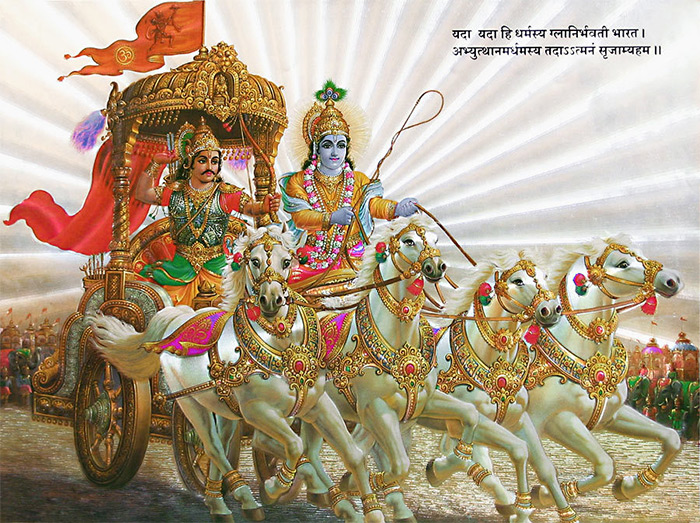


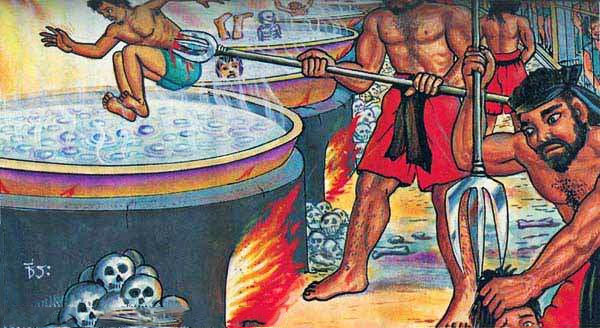
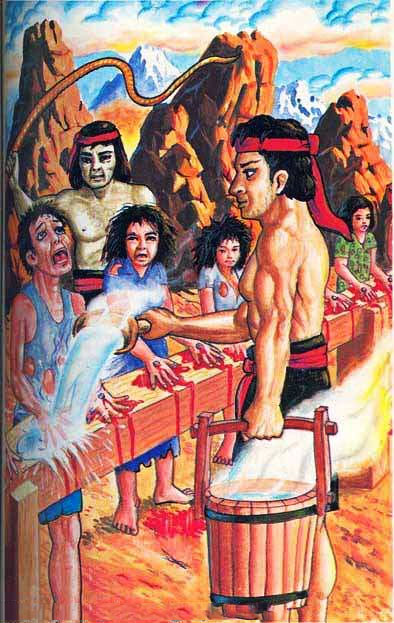
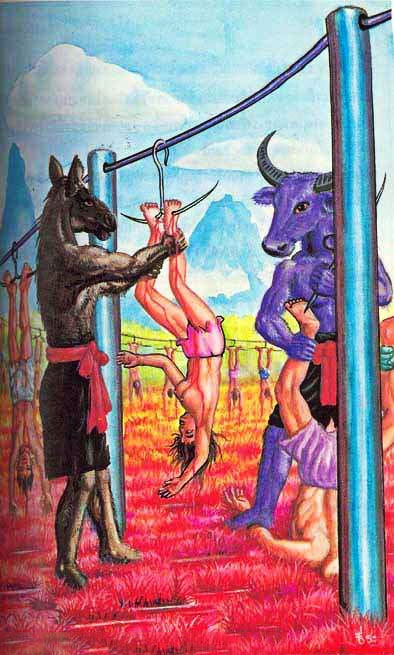
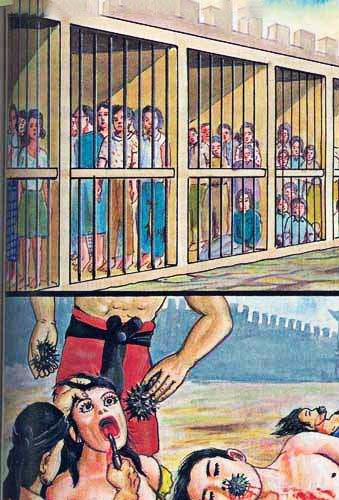
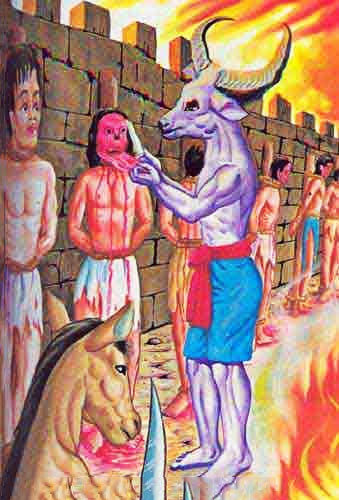
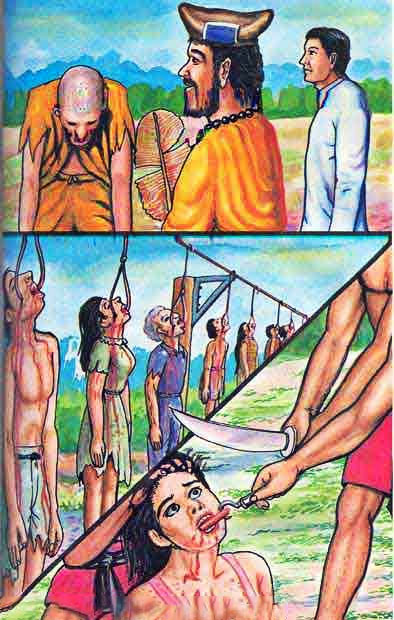
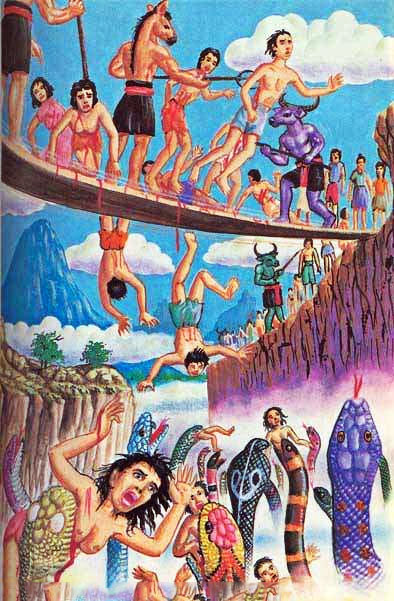
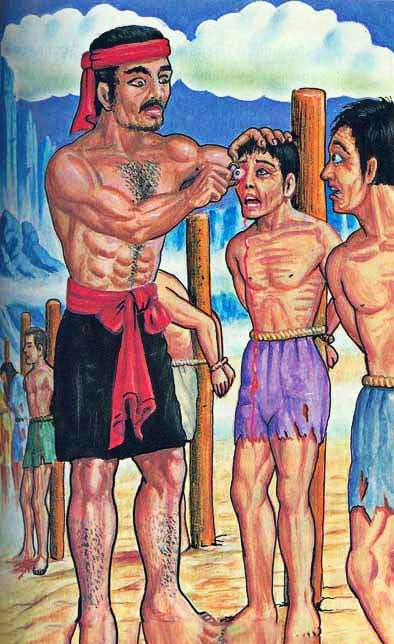

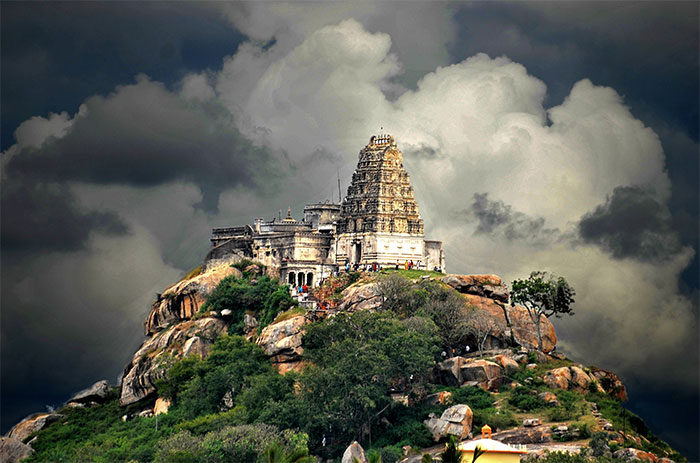 My American friend, Ved Bell, who is a follower of Mata Amrutanandamayi, asked me why is it that some Hindu temples didn’t allow him to go in. He has married to a Nepali Hindu woman. They follow Hinduism. Now that lot of African blacks, Caucasians, Chinese and people from other races follow sanatan dharma, our temples need to rethink about few conservative rules.
My American friend, Ved Bell, who is a follower of Mata Amrutanandamayi, asked me why is it that some Hindu temples didn’t allow him to go in. He has married to a Nepali Hindu woman. They follow Hinduism. Now that lot of African blacks, Caucasians, Chinese and people from other races follow sanatan dharma, our temples need to rethink about few conservative rules.